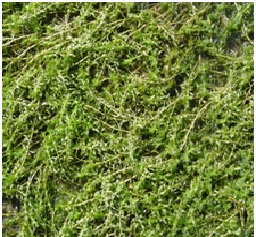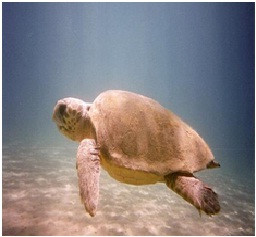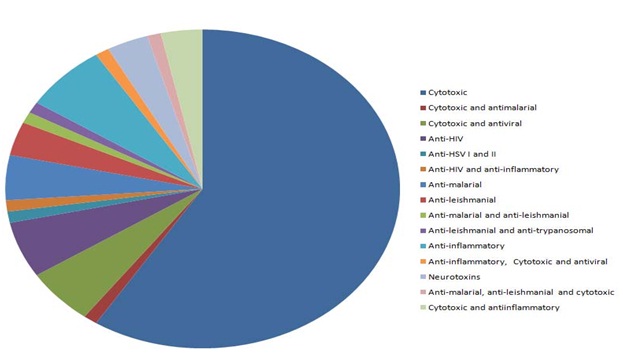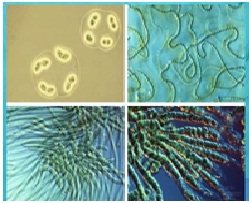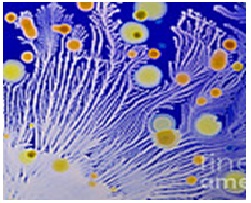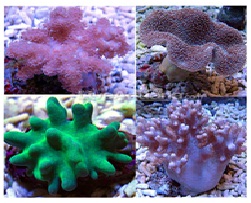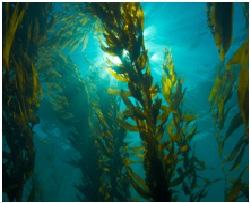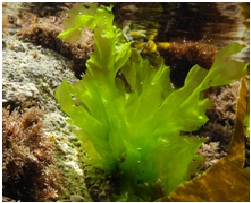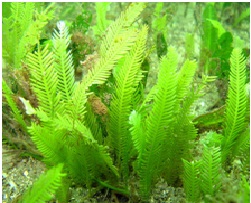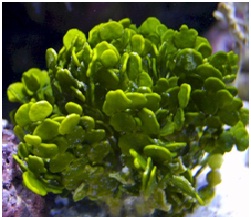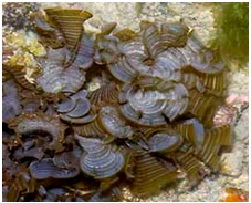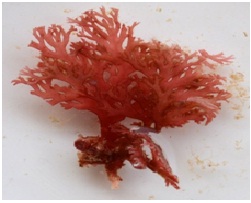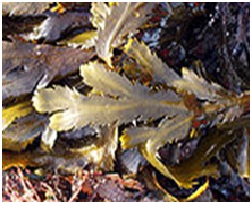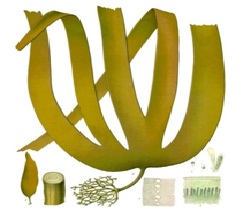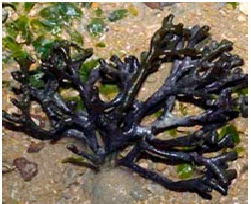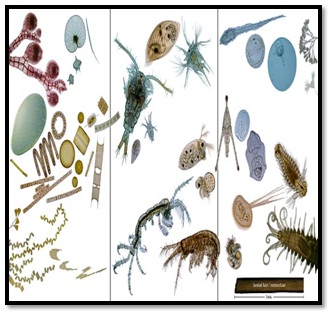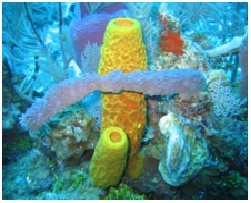|
Marine biotechnology is an emerging field focused on investigating and developing technological applications of living marine organisms, their derivatives, and their bioprocesses. Products derived from marine organisms have been utilized to remediate the environment, increase food supply, develop new industrial processes and create new pharmaceuticals.
Marine ecosystems and organisms are largely unexplored, understudied and underexploited, in spite of their potential to provide a major contribution towards addressing some of the most pressing societal challenges, including environmental degradation, human health and delivering sustainable supplies of food and energy. By solving some of these Grand Challenges marine biotechnology also holds potential for industrial innovation and responsible growth in Europe.
|
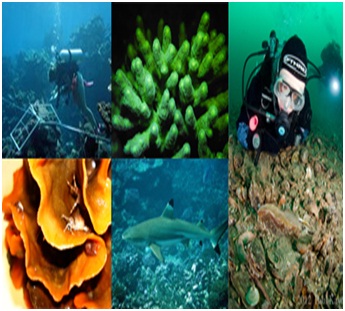 |
The Grand Challenges and a source of socio-economic growth and prosperity to countries investing in marine biotechnologies are:
- Marine Biotechnology securing Food supply
- Marine Biotechnology securing alternative sources of renewable Energy
- Marine Biotechnology securing Human Health
- Marine Biotechnology securing Industrial Products and Processes
- Marine Biotechnology securing Environmental Health
Global marine Biotechnology
A recent market research report estimates that the global market for products resulting from marine biotechnology might exceed US$ 4B by 2015, of which marine biomaterials (including seaweed hydrocolloids) could contribute over 40%, and marine bioactives for healthcare would be the most important and fastest-growing sector. The size of this, even if it is an over-estimate, suggests that the harnessing of marine bioresources through biotechnology and development of products and services. It is of interest that the report noted that very few countries have national marine biotechnology R&D programmes; it also identified the USA as the world leader in marine biotechnology.
Marine bioresources can give rise to specific molecules of tremendous use or potential for human medicine is undeniable. There are now 4 approved products, 13 in clinical trials and a large number in pre- clinical investigation, coming from a wide range of organisms from many different parts of the world. The route to market involves isolation and chemical characterisation, followed by synthesis or semi-synthesis of the molecule or an active analogue.
This CSA Marine Biotech report brings together as much information as can initially be found on national strategies for biotechnology and marine biotechnology, programmes and major research centres. It is intended to be a high-level overview and analysis of research, investments, research programmes and trends. It is also a ‘living document’, through the medium of the WIKI-pages of the MarineBiotech website to be corrected, expanded and brought up to date by interested parties who have access to direct knowledge and accurate information. It is also intended to raise interest in transnational collaborative possibilities between European countries and others.
The countries that are the focus of this report include those that are relatively highly active, such as USA, Brazil, Canada, China, Japan, Republic of Korea and Australia, as well as others where activities are growing from a smaller base (Thailand, India, Chile, Argentina, Mexico, South Africa) and where there are signs that marine biotechnology is increasing in importance as a research priority. Multinational regional approaches and infrastructures are also included where appropriate. It is notable that the major international effort, the Census of Marine Life (CoML), involved 2700 researchers, about 31% from Europe, 44% from USA and Canada, and 25% from the rest of the world, notably Australia, New Zealand, Japan, China, South Africa, India, Indonesia and Brazil.
OECD has established a steering group to develop a strategy for marine biotechnology, initiated by Norway in 2010 and now including Belgium, Canada, Denmark, France, Korea, Israel, Mexico, USA, the EU and the OECD’s BIAC (Business and Industry Advisory Committee). In addition, OECD maintains an interest in facilitating the international networking of Biological Resource Centres, to ensure that collections are properly managed.
In Africa, Mozambique has a coherent biotechnology plan. Otherwise, only Nigeria, South Africa and Tunisia seem to have any elements of biotechnology or marine sciences plans, policies or strategies. Kenya launched a national bioprospecting strategy in 2011 in response to biopiracy.
In Central & South America, Brazil and Chile have national biotechnology plans. Chile also has a national Innovation Plan (2012-2014). Argentina’s Law 26270 focuses on building the economy through facilitating biotechnology enterprise. Mexico has PECiTI (the national Science, Technology & Innovation programme), and a National Development Plan 2007-2012. No country has a marine biotechnology strategy, but Brazil carries out strategic R&D through a specific programme BIOMAR, established in 2005, and Costa Rica has an institute to manage the exploration and use of biodiversity, INBio, established in 1989.
In North America, Canada published its first National biotechnology strategy in 1983 and renewed it in 1998. Genome Canada was founded in 2000 as ‘a catalyst for developing and applying genomic sciences that create economic wealth and social benefit ‘. The USA announced in 2011 a National Bioeconomy Blueprint. Neither country has a specific marine biotechnology strategy, plan or policy. The Canadian marine strategy of 2002 and Healthy Oceans Initiative of 2007 contain some elements that might be relevant but the overall focus is on sustainability and integrated approaches to oceans.
In Asia, four of the most important players in marine biotechnology can be found, China, India, South Korea and Japan. Taiwan, Korea, Japan and India have specific national biotechnology strategies; in China, biotechnology is an integral part of the Five Year Plans. Individual Indian states have also established biotechnology policies (Gujarat for example). There are no separate national marine biotechnology strategies or policies except in Korea, where there is Blue-Bio 2016. In other major countries, marine biotechnology is mentioned as a specific topic in strategic plans or programmes (such as China, Japan’s BioStrategy 2002 or India’s 11th Five Year Plan). India also has a National Policy on Biofuels (2009) to which marine biotechnology is contributing. Korea has a plethora of strategies, policies and plans and marine biotechnology is an explicit part of the Biotechnology Fostering Policy.
In the Middle East, there appear to be no national biotechnology or marine biotechnology strategies, policies or plans. Israel had an economic development Bio-Plan 2000-2010.
In South-East Asia and the Indian Ocean Islands, Thailand and Vietnam stand out as the countries most focused on marine biotechnology. Indonesia, Malaysia, Singapore, Sri Lanka, Vietnam and Thailand have national biotechnology strategies, plans or policies. Only The Philippines, with NARRDS, the National Aquatic Resources Research & Development System, and Vietnam, with a recently-issued letter from the President of VAST (Vietnam Academy of Science and Technology) explicitly calling for increased efforts in marine biotechnology, have anything resembling a marine biotechnology policy or strategy.
In Australia-Pacific, both Australia and New Zealand have biotechnology strategies but neither has a specific marine biotechnology strategy. In New Zealand, the Biotechnology strategy includes marine biotechnology within environment/industry, and MoRST (Ministry of Research Science and Technology) produced a roadmap for biotechnology research in 2007, which included marine biotechnology as a specific component. In Australia, enhancement of access to marine resources and marine science are mentioned in the National Biotechnology Strategy (2000-2008) and its successor ‘Powering Ideas – An innovation agenda for the 21st century’, but marine biotechnology is not explicitly included. Australian States including Queensland and Tasmania do however include marine biotechnology as part of their research and economic development strategies. Marine Innovation South Australia includes and Aquaculture, Biotechnology and Biodiscovery Science group. Of the Pacific Islands, Guam and Fiji seem the most active in marine biotechnology. There are no obvious national strategies, but Fiji was an early mover in biodiversity (Access and Benefit-Sharing) policy development.
Coastal and Marine Bio-resources of India
India is bestowed with an extensive coastline of over 8129 km, 0.5 million sq.km. of continental shelf and 2.02 million sq. km. of exclusive economic zone (EEZ) and endowed with vast inland and marine bioresources, is the third largest producer of fish in the world.

Coastline of India
India’s coastline holds many biological treasures. Handsome mangrove forests of Sundarbans, the world’s largest congregations of nesting turtles in Odisha, beautiful seagrass beds in Palk Bay, enigmatic sea cows in the Gulf of Mannar, majestic yet gentle whale sharks in the Gulf of Kachchh and some of the world’s most beautiful and striking coral reefs are examples of the some of the biological treasures of India’s coastal and marine biodiversity.
Coastal ecosystems, which are among the most productive and biologically rich ecosystems, include several lakes, lagoons, marshes, mangrove .swamps, littoral zones and coral reefs. In the recent years, pressure on the coastal bioresources is on the rise. This necessitates action for conservation, sustainable and equitable utilization and genetic enhancement of the coastal bioresources. Coastal ecosystems, which are among the most productive and biologically rich ecosystems in our country, include several lakes, lagoons, marshes, mangrove .swamps, littoral zones and coral reefs. In the recent years, pressure on the coastal bioresources is on the rise.
This necessitates action for conservation, sustainable and equitable utilization and genetic enhancement of the coastal bioresources. Sustainable People-centered participatory management of coastal areas is required to ensure both ecological security of the coastal zones and the livelihood security of coastal communities. An in-depth understanding of the status of bioresources in coastal regions holds the key for developing any effective conservation and utilization strategy.
Bioresources are important for progress and economic activities of a nation. But bioresources management and utilization for human welfare is very important and critical component. The optimum utilization of the bioresources awareness of the importance and implications of bioresorves among common people as well as elite educated citizens for safeguarding and protecting the optimum and balanced way of using the bioresources well for the benefit of not only the present generation of our people but also to our future generations for their better, healthy and peaceful living on the earth. Biological resources include genetic resources, organisms or parts thereof, populations, or any other biotic components of ecosystems with actual or potential use for humanity (CBD, 1992).
National Bioresource Development Board has been involved in preparation of digitized inventories of plant, animal, microbial and marine resources of the country as well as implementing projects for the development of bioresource of specific regions of the country. As a part of the activities in the Coastal ecosystem, M.S. Swaminathan Research Foundation has been coordinating an integrated programme on conservation, characterization and enhancement of coastal bioresources in selected costal locations. The present compilation brings in the status; reports of the seven selected sites along both east and west coasts. This compilation is based on the available information on the status and threats to the ecosystem. I am sure this will help in developing effective strategy for conservation and sustainable utilization of bioresources. and will be useful for those interested in preservation of coastal areas and its biodiversity.
Bioprospecting of marine bioresources is a relatively new concept in comparison to the land bioprospecting. But according to some estimate the probability of discovering a drug from marine sources is thousand times more than that from terrestrial ones. It is therefore, many pharmaceutical companies across the globe are increasing their interest to harness the marine sources either of their own or with collaboration with different institutes. Because of the tremendous potential of marine bioresources, there is always threat for their over exploitation and increasing concern for their biopiracy. Again restricting pharmaceutical sectors from the access to the marine bioresources will encourage them to seek for alternate source of novel synthetic molecules through combinational chemistry. Therefore, it is highly essential at this point of time to go for proper documentation of prospective bioresouces of East Coast of India and their sustainable utilization in collaboration with the pharmaceutical sectors, within the framework of the existing law of the land, so that the states in particular and the country as a whole will get it due benefit out of its natural heritage.
- Sea weeds (Gracillaria, Gelidium, Porphyra, Tubinaria, Padina, Sargassum etc.)
- Horse Shoe Crab
- Other benthic Algae
- Mollusk (Cuttle fish, Lobster)
- Echinoderms
- Marine fishes
|
Corals: The extent of coral cover in Indian seas is 2375 km2. Reefs provide economic security to the communities who live alongside them. Traditional fishers and people whose livelihood is dependent on the reef perceive reefs as a source of food and revenue. They also perceive the reef as a defense against erosion caused by ocean waves. Diverse human activities such as runoff and sedimentation from developmental activities, eutrophication from sewage and agriculture, physical impact of maritime activities, dredging, destructive fishing practices, pollution from industrial sources and oil refineries have emerged as threats to the coral reefs. |
 |
Among natural threats, storms, waves and particularly cyclones are major stresses on corals. Another major challenge for sustainability of corals reefs is warming and acidification of seawater. As the reefs were common property, often conflicts in resource use were witnessed. Later, protection of all species of corals under Wildlife (Protection) Act 1972 and declaration of Marine Protected Areas and National Parks effectively reduced exploitation of corals. After the implementation of protection measures, the corals reefs are stated to be recovering from their status in the 1960s.
Mangroves: As per the State of Forest Report 2011, published by Forest Survey of India, the mangrove cover in the country stands at 4662.56 km2. Compared with 2009 assessment, there has been a net increase of 23.34 km2 in the mangrove cover of the country. This can be attributed to increased plantations in coastal States and regeneration of natural mangrove areas in the country. Mangrove ecosystems provide a life support system and income for people who use various Non Timber Forest Produces from them. In general the mangroves are resistant to environmental perturbations and stresses. However, mangrove species are sensitive to excessive siltation or sedimentation, stagnation, surface water impoundment and major oil spills. Salinities high enough to kill mangroves result from reductions in freshwater inflow and alterations in flushing patterns from dams, dredging and bulk heading. Seawalls, bunds and other coastal structures often restrict tidal flow, which is detrimental to the mangroves. In India, mangrove plantation programmes have been taken up, which are helpful in expanding the mangrove cover. The large expanse of inter-tidal mudflats (23,621 km2) may provide scope of adjustment and adaptation in some areas, mostly in the semi-arid region.
|
Seagrass: Seagrass ecosystem provides a sheltered, nutrient rich habitat for diverse flora and fauna. The habitat complexity within seagrass beds enhances the diversity and abundance of animals. There are several reports of reduction in the spread of seagrass meadows along the Indian coasts. Several causes have been attributed for the deterioration of seagrass beds. Eutrophication, siltation, trawling, coastal engineering constructions and removal for commercial purposes are the major threats for seagrass beds. Seagrass occurs in shallow water bodies below the low tide line and since water bodies are not brought under regulations, the CRZ notification is ineffective to protect sea grass beds.
|
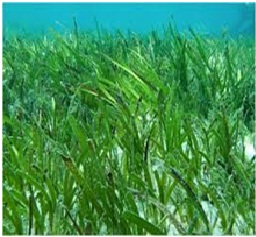 |
Seaweeds: Along the Indian coast, about 770 species of seaweeds are distributed, of this 184 species are green, 166 are brown and 420 are red algae. The estimated standing stock (wet weight) is about 541,340 t. Seaweeds are excellent breeding grounds for marine organisms, and are important as food for humans, feed for animals, fertilizer for plants, and for pharmaceutical purposes. Collection of wild seaweeds by the coastal population has reduced the seaweed cover over the years. Farming of seaweeds has become popular and is livelihood for coastal population in the Palk Bay and Gulf of Mannar (southeast coast of India).
|
|
Whaleshark: Until 2000, the whaleshark was exploited by unregulated and unsustainable fisheries to meet international trade demands for shark fins, liver oil, skin and meat. In July 2001, the whale shark was included in Schedule I of Indian Wildlife (Protection) Act, 1972, thus giving whaleshark protection and making it the first marine fish to be listed in the aforesaid Act. The whaleshark campaign has spread awareness on the species and the protected status in Gujarat (northwest coast of India). It helped convert the fishermen into protectors of the fish and brought about a change in the perception and attitude of local people.
|
|
Marine turtles: Of the seven species of turtles that occur in the world five breed along the Indian coasts. Among these, mass nesting of olive ridley occurs along Odisha coast (east coast of India) every year. Government of India is taking strict actions to protect the marine turtles under the Indian Wildlife (Protection) Act (1972), and in Appendix I of the Convention on International Trade in Endangered Species of Wild Fauna & Flora (CITIES). Fishing is prohibited during the mass nesting period of the olive ridley along the Odisha coast. Beach hatcheries are also in place in a few locations. |
|
Marine mammals: All species of marine mammals along the Indian coasts are protected under the Indian (Wildlife) Protection Act (1972). However, they continue to be affected by incidental capture in fishing operations. The population of dugong has reduced to low levels over the years.
|
 |
Sea cucumbers: As sea cucumbers were collected in large numbers and exported, the government prohibited the activity under Schedule I of the Wild Life (Protection) Act 1972. Central Marine Fisheries Research Institute has developed breeding techniques for sea cucumbers, enhancing the potential for sea ranching the seed for stock improvemen
|
|
East Coast
This east coastal plain begins from the north with the plains formed by the Subarnarekha River to extend to the south till Kanyakumari. It thus stretches for nearly 1500 km, with nearly a width of 100 km. to the east of this plain lies the extensive blue waters of the Bay of Bengal and to the west of the plain lies the remnants of Eastern Ghat hills.
|
The East Coast of India that stretches from Tamil Nadu in the south to West Bengal in the east is a wide stretch of land lying between the Eastern Ghats and the oceanic boundary of India. The Mahanadi, Godavari, Krishna and Kaveri are the major rivers that drain the East Coastal Plain to Bay of Bengal. The length of this coast line is about 1931 km and is very rich in biodiversity which include different species of benthic algae, seaweeds, sea grass, lobsters, sponges, echinoderms, crabs, bivalves, gastropods, cephalopods etc. The estuaries along this coast including Sunderban and Bhitarkanika are rich in mangrove vegetation forming a typical environment which harbor many endangered species of plants and animals. Many species of both plants and animals of this region are economically important and are therefore, harvested from their natural habitats as bioresources.
West coast
The Western Coastal Plains is a thin strip of coastal plain 50 kilometres (31 mi) in width between the west coast of India and the Western Ghats hills, which starts near the south of river Tapi. They are bodied between the Western Ghats and the Arabian Sea. The plains begin at Gujarat in the north and end at Kerala in the south. It also includes the states of Maharashtra, Goa and Karnataka. It consists of three sections. The Northern part of the coast is called the Konkan (Mumbai-Goa), the central stretch is called the Kanara, while the southern stretch is referred to as the Malabar Coast. On its northern side there are two gulfs: the gulf of Khambat and the gulf of Kachch.
Corals: Despite the Vastness of the Indian subcontinent and the warm temperature of its coastal waters, coral reefs are present on only a few widely scattered parts of the mainland coast: the Gulf of Kutch in the northwest; off the southern mainland coast. The reefs off the mainland coast and on nearshore islands are mainly fringing and, apart from a few areas, are still poorly known. The Gulf of Kutch has many islands on its southern side around which are shallow reefs, often backed by mangroves.
|
Mangroves: Mangroves grow in conditions where few other plant species can survive. Mangrove plants also display features similar to those in desert plants which tend to conserve water. The best mangrove growth and development occurs where the seasonal temperature variation does not exceed 10°C and where the air temperature in the coldest month is higher then 10°C.
|
 |
Seaweeds: Seaweeds are primitive type of plants lacking true roots, stems and leaves. Most seaweeds belong to one of three divisions. There are about 900 species of green seaweed, 4000 red species and 1500 brown species found in nature. The greatest variety of red seaweeds is found in subtropical and tropical waters, While brown sea weeds are more common in cooler, temperate waters.
|
National strategy for marine biotechnology |
India occupies a strategic position in the Indian Ocean, with a large Exclusive Economic Zone, EEZ of about 2.172 million square kilometers in the area along 7500 Km coastal line, shelf area of 1,641,514 KM2. A major challenge facing India in the 21st century is to continue to advance in science to provide for the sustainable development and management of this vast realm.
At national level, DBT has a Task Force on Aquaculture and Marine Biotechnology, set up in 1998, which oversees individual research projects and network projects with national and international partners. The 11th Five Year Plan (2007-2012) mentions marine bioresources as elements of the biotechnology/science & technology aspects, including bioresource development and utilization and increased productivity and disease management in aquaculture, in the report of the DPB and biotechnology working party.
At state level, Gujarat identifies “the key activities in marine biotechnology … screening of marine resource for new molecules/active compounds, bio-prospecting of marine resource, conservation of marine bio-diversity, extraction of value added products and utilization of marine bio-mass etc. The state would focus on mangrove, sea weed and marine micro flora- fauna”. The plan includes a marine biotechnology centre, but remains to be fulfilled.
India’s National Policy on Biofuels was released in 2009 and requires 20% blending of biofuel with petrol and diesel by 2017. In addition to work on land-based biomass and wastes, this has stimulated research and demonstration on algal biofuels, funded by DBT and the New Millennium Indian Leadership Initiative (NMILI). In addition to use of macroalgae for ethanol and biogas, there is a strong focus on Botryococcus braunii as a lipid-generating microalga. The US’s NREL completed a report in 2010 that pinpointed a very strong future for India in algal biofuels, based on a combination of light, temperature, available land and availability of inputs. The report estimates that 45%-100% of India’s diesel requirements could be replaced by algal biodiesel under favourable conditions and using no more than 10% of the current waste land area.
Although DBT is the major funder of biotechnology projects, there is increasing coordination with the other central organisations such as DST, CSIR, MES and ICAR (Indian Council of Agricultural Research), to avoid duplication of research funding. Under the Task Force on Aquaculture and Marine Biotechnology, DBT has funded over 200 projects since 1998. The biotechnology-based projects explore detection, monitoring or prevention of diseases of farmed fish and shellfish, including the use of bacteriophages, and detection of food-borne toxins and pathogens. There has also been work on establishing fish and shellfish cell lines and, increasingly since 2006, publications on bioactives (including antimalarial compounds), biosurfactants and other active molecules from marine microbes and macroalgae . Water bioremediation using aquatic microorganism consortia is also a topic.
The DBT has helped fund Biotechnology Parks or Incubation Centres in Lucknow Uttar Pradesh, Bangalore Karnataka, and in Kerala, Punjab and Himachal Pradesh states. Guwahati Biotech Park Incubation Centre has recently been launched. There is some activity by State and Central Governments to assist industry in developing marine biotechnology, including infrastructure such as marine biotech science parks, research centres and training, but nothing is yet established. Examples of future plans include: Gujarat – a dedicated Marine Biotechnology Park at Jamnagar or Bhavnagar; Andhra Pradesh - a 218-acre Marine Biotech Park (MBP) in Visakhapatnam; Tamil Nadu – and investment of over US$11M in a Marine Biotechnology Park at Mamallapuram, with incubators for pharmaceutical, food supplements and cosmetic developments; Karnataka – a joint plan between the Department of Fisheries and the University of Agricultural Sciences Dharwad for a marine biotech park at Karwar. The University of Science and Technology at Cochin, Kerala, is planning a Centre for Marine Biotechnology to work on genotypic characterization, gene-sequencing and isolation of novel enzymes and marine natural products and biomaterials, as well as establishing a database on marine biotechnology.
Marine biotechnology is carried out by CSIR-funded laboratories including the National Institute of Oceanography (NIO), Goa and Central Salt and Marine Chemicals Research Institute (CSMCRI) and Universities and establishments funded by the Department of Biotechnology (DBT), including structural and functional genomics, cultivation of seaweeds, bioprospecting and bioactives, microbial extremophiles, bioremediation. DBT’s biotechnology work includes fish and crustacean farming, with aspects such as disease diagnostics and vaccine development, bioactive compounds and transgenics.
A program on “Development of Potential Drugs from the seas around India” is an ongoing project at the National Institute of Oceanography (NIO) in collaboration with Central Drug Research Institute (CDRI), Lucknow, Indian Institute of Chemical Technology (IICT), Hyderabad, Advanced Centre for treatment, research and education in Cancer (ACTREC) and ten other laboratories. The Ministry of Earth Sciences (MoES), New Delhi, supports this program. Under this program, therapeutic potential of several isolated and identified compounds have been explored and there are hopes of few of the lead compounds identified reaching the drug stage. Bioactive molecules are isolated and purified using the latest state-of-art technology in the field of natural product research. Structural elucidation is affected using the most modern sophisticated instrumentation techniques which include Fourier Transform Infrared spectroscopy (FTIR), Nuclear Magnetic Resonance spectroscopy (NMR), Mass Spectroscopy (MS), etc.
|
Recent Developments in the Field of Biotechnology in India.
|
a) Relevance of biofilm bacteria in modulating the larval metamorphosis of Balanus amphitrite
Natural microbial communities found on different substrata- exposed marine environment, including barnacle shell surfaces, causing varied influences on the settlement and metamorphosis of competent larvae. Experiments were carried out to compare the influence of settlement inducing compounds from the bacteria isolated from the shell surface of Balanus amphitrite on its larval metamorphosis. The effect of multispecies bacteria was also assessed. The production of different molecules by the bacteria was influenced by the nutrient media under which they were grown. It was observed that the promontory multispecies bacterial film turned to inhibition mode in the presence of the adult extract of the barnacle, indicating that bacteria–adult interactions alter the synthesis of different compounds produced by bacteria. Studies have also shown that the waterborne and the surface-associated cues from bacteria function differentially in mediating larval metamorphosis. Understanding the complexities involved in such interactions and identification of the condition governing them would be a step forward.
b) Aerobic degradation of highly chlorinated polychlorobiphenyls by a marine bacterium, PseudomonasCH07
Hitherto, aerobic degradation of polychlorinated biphenyls (PCBs) has been reported to be limited to the less chlorinated biphenyls. A marine mercuryresistant bacterium, Pseudomonas CH07 (NRRL B- 30604) which was capable of degrading a variety of highly chlorinated congeners of PCBs from the technical mixture Clophen A-50 is reported. Of the two most toxic coplanar PCBs present in Clophen A-50, one coplanar pentachloro congener CB-126 and one toxic sterically hindered heptachloro congener CB-181 were found to be degraded completely and the other coplanar tetrachloro congener CB-77 was degraded by more than 40% within 40 h by this microorganism. The apparent absence of bphC in this bacterium leads to the proposal of a different mechanism for degradation of PCBs.
c) Molecular evidence of fungal signatures in the marine protest Corallochytrium limacisporum and its implications in the evolution of animals and fungi
Fungi, animals, and single-celled organisms belonging to the choanozoans together constitute the supergroup Opisthokonta. The latter are considered crucial in understanding the evolutionary origin of animals and fungi. The choanozoan Corallochytrium limacisporum is an enigmatic marine protist of considerable interest in opisthokontan evolution. Several isolates of the organism were obtained from a coral reef lagoon in the Lakshadweep group of islands of the Arabian Sea. The ability of these cultures to grow on media containing inorganic nitrogen sources prompted us to examine the possible presence of fungal signatures, namely the enzyme aminoadipate reductase (AAR) involved in the aminoadipate (AAA) pathway for synthesizing lysine and ergosterol, in one of the isolates. These features, as well as the sterol C-14 reductase gene involved in the sterol pathway of animals and fungi, were detected in the organism. Phylogenetic trees based on the AAR gene suggested that Corallochytrium limacisporum is a sister clade to fungi, while those based on the C-14 reductase gene did not adequately resolve whether the organism was more closely related to fungi or animals.
|
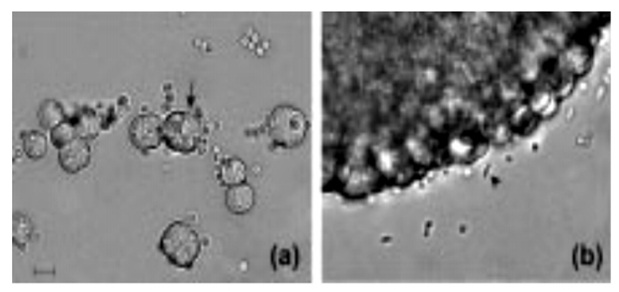
Photomicrograph of Corallochytrium limacisporum cells. (a) The organism ischaracterized by single cells, diads and tetrads (arrow). (b) Reproduction takes place by the production of limax-shaped amoeboid spores (arrowhead)
|
d) Glycolipids from the red alga Chondria armata (Kutz.) Okamura
Three distinct fractions containing polar glycolipids (PF1–3) were isolated from the chloroform soluble fraction of crude methanolic extract of red alga Chondria armata (Kutz.) Okamura on gel chromatography over Sephadex LH20. Their structure was elucidated and indicated an exclusive configuration of the sugar molecules in theglycerolipids. Major glycolipids were identified as (2R)-2-O-(5,8,11,14-eicosatetranoyl)-3-O- -Dgalactopyranosyl-snglycerol (GL2), its pentacetate (GL1), and (2R)-1-O-(palmitoyl) -2-O-(5,8,11,14,17-icosapentanoyl)-3-O- -D-galactopyranosyl-sn- glycerol (GL3). Each was methanolysed to give the same galactosylglycerol which on ESI-MS provided a pseudomolecular ion at m/z 309 representing deacylated glycolipid with the sodiated sugar moiety. Additionally, six minor glycolipids were also identified on the basis of ESIMS. These include 1,2-di-O-acyl-3-O-(acyl-6′-galactosyl)-glycerol (GL1a), sulfonoglycolipids 2-Opalmitoyl-3-O-(6′-sulfoquinovopyranosyl)-glycerol (GL2a) and its ethyl ether derivative (GL2b), 1-oleoyl-2 palmitoyl-3-Ogalactosyl glycerol (GL3a), and 1,2-diacyl phosphatidyl glycerol (GL3b). GL1, GL1a, and GL2b are new to the literature. The novelty of the remaining identified compounds lies in the diversity of their fatty acid composition. Antimicrobial properties of these glycolipids against pathogens were evaluated. The yeast Candida albicans and the bacteria Klebsiella sp. were as sensitive as the standard Nystatin and antibiotic Streptomycin
against PF3. Considerable activity was expressed by the same metabolite against the fungus Cryptococcus neoformans as compared to the control. Weak activity against the bacteria Shigella flexineri and Vibrio cholerae and the fungus Aspergillus fumigatus was also observed. Fraction PF2 was weakly active against some strains whereas all of them were resistant to its acetyl derivative PF1. Antimicrobial activity of glycolipids was reported here for the
first time.
e) Biotransformation of citrinin to decarboxycitrinin using an organic solvent-tolerant marine bacterium, Moraxella sp. MB1
Organic solvent tolerant microorganisms (OSTMs) are a novel group of extremophilic microorganisms that have developed resistance to withstand solvent toxicity. These organisms play an important role in biotransformation of organic compounds. An organic solvent-tolerant marine bacterium, Moraxella sp. MB1 is used. 16S rRNA sequencing revealed that the bacterium shows 98% similarity with an uncultured marine bacterium with GenBank accession no. AY936933. This bacterium was used for the transformation of a toxin, citrinin, into decarboxycitrinin in a biphasic system. This transformation was affected by decarboxylase enzyme produced by MB1. Transformation of citrinin to decarboxycitrinin was monitored spectrophotometrically and by thinlayer chromatography (TLC). Citrinin decarboxylase activity responsible for transformation was studied in cell-free growth medium and cell lysate of Moraxella sp. MB1. Citrinin decarboxylase was found to be intracellular in
nature. The biotransformed product was purified and identified as decarboxycitrinin using electrospray ionization mass spectrometry (ESI-MS/MS) and nuclear magnetic resonance (NMR) spectrometry. The antibiotic activity of both citrinin and decarboxycitrinin is reported.
f) Antiviral property of marineactinomycetes against white spotsyndrome virus in penaeid shrimps
Aquaculture farms, particularly in Southeast Asia are facing severe crisis due to increasing incidences of White Spot Syndrome Virus (WSSV). Actinomycetes have provided many important bioactive compounds of high prophylactic and therapeutic value and are continually being screened for new compounds. In this communication,
the results of a study made to determine the effectiveness of marine actinomycetes against the white spot disease in penaeid shrimps are presented. Twenty-five isolates of actinomycetes were tested for their ability to reduce infection due to WSSV among cultured shrimps. When these actinomycetes were made available as feed additives
to the post-larvae of the black tiger shrimp Penaeus monodon for two weeks and challenged with WSSV, the post challenge survival showed variations from 11 to 83%. However, six isolates have shown to be the most potential candidates for further study.
g) Isolation, purification and characterization of xylanase produced by Arthrobacter sp. MTCC 5214 when grown in solid-state fermentation
Thermoalkalophilic Arthrobacter sp. Produced extracellular xylanase when wheat bran, rice husk,rice bran and bagassae were used as carbon source under solid-state fermentation (SSF). The xylanase enzyme was isolated by ammonium sulfate (80%) fractionation, and purified to homogeneity using size exclusion and ion exchange chromatography. The molecular mass of xylanase was ~20 kDa. Enzyme retained 100% activity at pH 7 and 8 for 24 h. It was interesting to note that at higher pH such as 9, 10 and 11 the enzyme activity increased over the period of
incubation. The optimum temperature for the enzyme activity was 100°C at pH 9.0. At 80°C and pH 9, half-life of enzyme was 30 min. Half-life of enzyme at 70 and 60°C was 18 and 24 h, respectively. While at 50°C the enzyme retained 79% of activity even after 48 h. For xylan, the enzyme gave a Km value of 0.9 mg/ml, and Vmax value of 3571 mol/min/mg when the reaction was carried out at 100°C and pH 9. In the presence of metal ions such as Co2+, Zn2+ Fe2+, Cu2+, Mg2+ and Ca2+ and metal chelator EDTAthe activity of the enzyme increased. Whereas strong inhibition of the enzyme activity was observed in the presence of Hg 2+. These are some novel characteristics that make this enzyme potentially very effective for industrial applications.
h) Alpha-L-Arabinofuranosidases: The potential applications in biotechnology
Recently, alpha -L-arabinofuranosidases (EC3.2.1.55) have received increased attention primarily due to their role in the degradation of lignocelluloses as well as their positive effect on the activity of other enzymes acting onligno celluloses. As a result, these enzymes are used in many biotechnological applications including wine industry, clarification of fruit juices, digestion enhancement of animal feedstuffs and as a natural improver for bread.
Moreover, these enzymes could be used to improve existing technologies and to develop new technologies. The production, mechanisms of action, classification, synergistic role, biochemical properties, substrate specificities, molecular biology and biotechnological applications of these enzymes have been reviewed.
l) Enhanced production of laccase by a marine fungus during treatment of colored effluents and synthetic dyes
Paper and pulp mills, textile and dye-making industries and alcohol distilleries release highly colored effluents that are relatively difficult to decolorize by chemical and physical treatments. White-rot basidiomycetous fungi that produce lignin-degrading enzymes are reported to be most efficient in decolorizing such effluents. Decolorization of all the three effluents by a marine fungal isolate, NIOCC#2a cultured from decaying mangrove wood is reported.
The fungus also decolorized several synthetic dyes. Laccase was the most dominant lignin-degrading enzyme produced by this fungus with very low activities of manganesedependent peroxidase and no lignin peroxidase activity. The growth and production of laccase was best in a medium prepared with seawater having salinity in the range of 25–30 ppt. The pH optimum for the laccase activity was 3.0 and 6.0 and the temperature optimum was 60°C. Laccase production was increased in the presence of phenolic and nonphenolic inducers. A several fold
enhancement in laccase production was found during treatment of colored effluents from textile, paper and pulp mill and distillery waste. Industrial effluents and synthetic dyes added to the growing culture of this fungus were decolorized to a great extent. The culture supernatant without the fungal biomass was also effective in decolorization of these effluents to various degrees within h of incubation. Extracellular polymeric substances (EPS) produced by this fungus were also useful in decolorization of these effluents. Thus, efficiency of this fungus in decolorization of various effluents with laccase that is active at pH 3.0 and 6.0 and 60°C in the presence seawater has great potential in bioremediation of industrial effluents. Enhanced laccase production in the presence of industrial effluents by this fungus is an added advantage during bioremediation of effluents.
m) Pink-line syndrome, a physiological crisis in the scleractinian coral Porites lutea
Coral diseases are one of the major factors that alter coral cover and their diversity. The 'Pink line syndrome' (PLS) in the scleractinian coral Porites lutea wherein a colored band appears between the dead and healthy tissue of a colony is reported earlier. About 20% of the P. lutea colonies were affected in Kavaratti of the Lakshadweep Islands
in the Arabian Sea during April 1996 and the incidence increased fourfold within the next 4 years. Fungi were associated in both PLS-affected and healthy specimens, whereas the cyanobacterium Phormidium valderianum occurred exclusively in the PLS-affected specimens. There was an increased expression of a 29 kDa protein without
any significant increase in total protein content in the PLS affected colonies. Areduced number of zooxanthellae and an increase in zooxanthellae size, mitotic index, and chl a concentrations were some of the characteristics of the PLS-affected colonies. PLS induction experiments conducted using selected fungi and the cyanobacterium P. valderianum isolated from the affected colonies and abiotic factors, such as CO2 enrichment and the effect of cyanobacterial photosynthesis inhibition, indicated that the CO2 build-up around the host tissue caused the pink
coloration. It is hypothesized that these physiological changes disturb the mutualism between the zooxanthellae and the host. When the symbiosis is disturbed by the external CO2, the host loses control over the zooxanthellae, causing their uncontrolled division. This process may lead to a break in photosynthate transfer to the host, thereby resulting in starvation and finally leading to partial mortality. It is hypothesized that these degenerative processes are triggered by the CO2 produced by P.valderianum through its carbon concentration mechanism. In this context, any opportunistic cyanobacteria or other agents having potential to interfere with the physiology of the host or the symbiont can cause such a physiological disorder. The mechanism of PLS formation is an early warning to protect corals as the increasing atmospheric CO2 could induce PLS-like physiological disorder in corals.
|
n) Reaction of elemol with acetic acid/perchloric acid: Characterization of a novel oxide and -â(+)-cyperone.
The minor unidentified compounds of the acetic acid/perchloric acid dehydration of elemol (1) were fully characterized. The structure and relative configuration of the less polar fragrant compound 2, named elemoxide, was deduced by ID- and 2DNMR data including C,C connectivity, NOE, and NOESY experiments. The absolute configuration was established as (3S, 3aft, 7aft)-l,3,3a,4,7,7a-hexahy-dro-6-isopropyl-l,l,3,3atetramethylisobeiizofuran(2) on the basis of its preparation from elemol (1). -cyperoneâ(+)- (3), a known sesquiterpene, was also identified as a minor product of the reaction. A plausible mechanistic explanation for the cyperonc (3) is presented.âformation of elemoxide (2) and (+)-cyperonc (3) is presented.
o) Effect of nutrient nitrogen on laccase production, its isozyme pattern and effluent decolorization by the fungus NIOCC No. 2a, isolated from mangrove wood.
Carbon and nitrogen sources in the growth medium play an important role in the production of lignindegrading enzymes in the white-rot basidiomyceteous fungi. The role of nutrient nitrogen sources in growth media on production of lignin degrading enzymes namely laccase, lignin peroxidase and manganese peroxidase as well as on the decolorization of industrial effluents like black liquor, molasses spent wash and textile mill effluents was studied using the basidiomycetous fungus NIOCC No.2a isolated from mangrove wood. The results indicated that the type of nitrogen source used, not only influences the amount and type of lignin-degrading enzymes produced but also has an effect on the decolorization of these effluents. The amount of extracellular peroxides increased by several fold in the presence of effluents whereas in their absence they were of negligible quantity. Some of the effluents had an inhibitory effect on laccase production. The effect of nitrogen sources in the absence as well as presence of the effluents, on the expression of laccase isoenzymes was studied by non-denaturing SDS-PAGE. It was noticed that a few new isozymes of laccase were induced in the presence of industrial effluents. Decolorization of these effluents by the concentrated culture filtrate obtained from media containing different nitrogen sources further proved the importance of the type of nitrogen source in decolorization of colored industrial effluents.
p) Removal of polycyclic aromatic hydrocarbons from aqueous media by the marine fungus NIOCC 312: Involvement of lignin-degrading enzymes and exopolysaccharides.
The removal of polycyclic aromatic hydrocarbons from aqueous culture medium by the lignindegrading marine fungus NIOCC 312, obtained from decaying seagrass from a coral reef lagoon is reported here. The percentage of phenanthrene removed from the culture supernatant and the fungal biomass after 6 days is estimated. About 60-70%
of phenanthrene, at a concentration of 12 mgl-1 (12ppm) was removed from the culture medium containing live or heat-killed fungus, as estimated by fluorescence spectroscopy method. Nuclear magnetic resonance spectra of the phenanthrene extracted from the fungal biomass revealed that in the heat-killed fungal biomass, the phenanthrene remained undegraded till day 6. On the other hand in the live fungal biomass, no phenanthrene was detected on day 6 suggesting that it was metabolized or transformed into non-aromatic fragments. It is concluded that the disappearance of phenanthrene from the aqueous culture medium is due to its instant adsorption to the fungal biomass owing to the presence of the exopolymeric substance (EPS) around the fungal hyphae. The EPS produced by the fungus was partially characterized. It is hypothesized that phenanthrene thus adsorbed by the live fungal biomass was subsequently degraded by the lignin-degrading enzymes present in the cell wall and the EPS envelope. Thus, the heat-killed fungal biomass could be used only for adsorption of PAHs from contaminated sites whereas
use of the live fungal biomass would result in degradation of PAHs.
q) New Caulerpenyne-derived metabolites of an Elysia Sacoglossan from the south Indian coast
Chemical analysis of the secondary metabolite pattern of the sacoglossan mollusc Elysia cf.expansa, collected along South Indian coasts, showed the presence of the typical Caulerpa derived sesquiterpene caulerpenyne (1) and two new minor cooccurring metabolites, the compounds dihydrocaulerpenyne (4) and expansinol (5). The chemical
characterization of these molecules, structurally related to 1, is reported.
|
Recent advance in marine drug research |
During the last decade, marine biotechnology has already shown signs of fulfilling the promise of delivering products that would contribute to health care, food and chemical production. Table 1 gives examples of pharmaceuticals based on marine biotechnology that have already been commercialized. Until four decades ago, the major impediment tom the search for marine natural products was the inaccessibility of the organisms. Early studies were carried out only with intertidal and shallow subtidal environments. However, with advances in diving technology, the availability of remotely controlled vehicles and submersibles. Samples from depth of over 1000 m can be collected and examined.
Though serious research in the field of marine pharmacology is of very recent origin, a few products (or their analogues) have already appeared in the market as therapeutic drugs or health food. This includes ω-3 poly unsaturated fatty acids (PUFA, cholesterol-lowering), Ara-C (Cytarabine, anticancer), Ara-A (antiviral), ziconotide (analgesic), Trabectidin (anti-cancer) etc. In addition, several more compounds such as bryostatin, didehydrodidemnin, eribulin mesylate, dolastatins, kahalalide F, KRN 7000, squalamine, etc., are at different stages of clinical trials (Mayer et al, 2010).
The advances in the field of marine metabolites exhibiting diverse biological properties up to early 2008 period have recently been compiled (Mayer et al. , 2011). Subsequently, 3079 new
compounds have been added to the literature during the next 4 year period, 2008-2011, (Blunt et al. , 2010, 2011, 2012). As the purpose of this review was to short-list marine compounds of therapeutic potential for common human ailments like cancer, inflammation and infectious diseases, only compounds having IC50 values < 15 µM are included here. Thus, this review lists 136 cytotoxic, 31anti-infectious and 24 anti-inflammatory compounds reported during the years 2008-’11 (Fig 1). But for a handful of compounds, which displayed activity at concentrations higher than 10 µM, most of these compounds were active at submicro-molar levels. Broadly, these bioactive compounds may be classified into diverse structural types: terpenes, non-terpenes, alkaloids and peptides. The nonterpenoid compounds belong to both acetogenic (C2) and propionate (C3) biosynthetic pathways. Peptides may be either linear or cyclic, including lipopeptides, depsipeptides, etc. Many of these peptides contain L- or D- amino acids, ß-amino acids, or other structurally modified amino acids of non-ribosomal origin.
Biomedical |
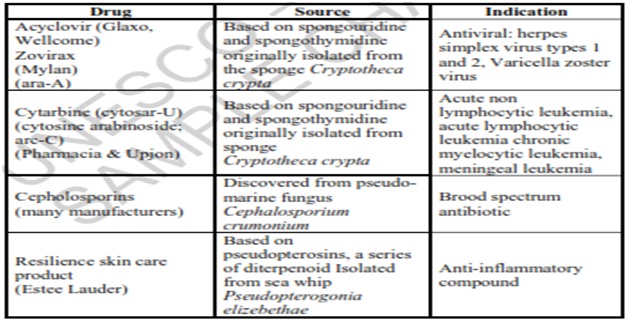
Table. Drugs already developed marine biotechnology
|
Fig: Classification of compound based on their bioactivity. |
|
|
1. Marine Sponges
Marine sponges (Phylum: Porifera) constitute one of the most primitive multicellular organisms (> 600 million years old) on earth. Due to their long evolutionary history, these organisms possess vast genetic diversity, producing several novel metabolites of potential biomedical applications. The isolation of sponge-derived antiviral and anticancer nucleosides (spongothymidine and spongouridine) in early 1950’s heralded a new era in modern biomedical research. Subsequent studies over the last six decades have led to the discovery of several novel metabolites, displaying promising biological properties.
|
|
2. Marine Cyanobacteria
The prokaryotic cyanobacteria continue to be an important source of structurally diverse, bioactive metabolites. A majority of these metabolites are complex peptides, depsipeptides or lipopeptides, containing unusual amino acids, multiple N-methylations and lipids of mixed biogenesis. These compounds have been isolated from pure cultures as well as from wild collections. Out of the promising 21 organisms studied, 11 species yielded cytotoxic compounds, three mixed cultures yielded neurotoxins, yet another three had antileishmanial and one culture, anti-inflammatory compounds.
|
|
3. Marine Actinomycetes
Marine actinomycetes continue to be a good source for novel bioactive compounds (esp. antitumor, antimalarial and antimicrobial agents) of mixed biogenesis. Their novel structures, promising biological properties and prospects of fermentation-based mass production have led to a renewed interest in the search for potential drugs from this group of marine microorganisms. Herein we report the novel cytotoxic compounds isolated from this promising group of microorganisms during the last four years.
|
|
4. Soft corals (order Alcyonacea, class Anthozoa)
Soft corals are a rich source for bioactive compounds including prostanoids, different sterols and cyclic diterpenoids.
|
|
5. Seaweeds
Marine macroalgae, or seaweeds, are plant-like organisms that generally live attached to rock or other hard substrata in coastal areas. They belong to three different groups, empirically distinguished since the mid-nineteenth century on the basis of thallus color: brown algae (phylum Ochrophyta, class Phaeophyceae; see right for a large brown kelp, Durvillaea in New Zealand), red algae (phylum Rhodophyta; below Gelidium in Ireland), and green algae (phylum Chlorophyta, classes Bryopsidophyceae, Chlorophyceae, Dasycladophyceae, Prasinophyceae, and Ulvophyceae; bottom, Ulva howensis in Lord Howe Island, off eastern Australia)
|
Fucoidan
Fucoidan is a sulfated polysaccharide found mainly in various species of brown algae and brown seaweed such as mozuku, kombu, bladderwrack, wakame, and hijiki (variant forms of fucoidan have also been found in animal species, including the sea cucumber). Fucoidan is used as an ingredient in some dietary supplement products.
It can be easily cooked out of most edible brown algae by simmering 20-40 minutes in water (alone or in food). When consumed, it seems to reduce the intensity of the inflammatory response and promote more rapid tissue healing after wound trauma and surgical trauma. This means that brown seaweed broth is recommended after auto collision, sports injuries, bruising falls, muscle and joint damage, and deep tissue cuts, including voluntary surgery.
|
|
Ulva
This is a small genus of marine and brackish water green algae. It is edible and is often called 'Sea Lettuce'. Nutritionally Ulva is a rich source of iodine, aluminum, manganese, magnesium, sodium, potassium, copper, zinc, trace elements and ash. It is high in iron (15 times greater than egg yolk or spinach) and calcium. Green (Ulva) seaweed contains 27% protein, which is comprised of all 9 essential amino acids including Lysine which is the amino acid that is typically deficient in most vegetarians. 50% is comprised of sugar and starch, and it contains less than 1% fat. It is also high in protein, and contains a plethora of essential Vitamins (A, C, E, riboflavin, pantothenic acid, niacin, B12, choline, biotin, folic acid and thiamin). Sea lettuce provides considerable amounts of dietary fiber (31%), and because this seaweed is a good source of vitamin B-12 which is important for vegans and vegetarians.
|
|
Antioxidant properties – Sea Lettuce is rich in vitamins and antioxidants that can neutralize free radical damage, thereby guarding us from a myriad of health conditions such as macular degeneration and cancer. Additionally, this nutrient rich seaweed has excellent skin-boosting properties. Sea Lettuce contains natural photosynthetic pigments that give it that green colour. It has a high concentration of A-Chlorophyll, B-Chlorophyll, Xanthophylls, Lotein, Beta and Gamma Carotene, Siphonxantine and Siphonein.
Beta Carotene is essential to your eye’s health and has antioxidant properties. Lotein is an essential for repairing sun damage to your eyes and UV rays on your skin, and acts as an antioxidant.
Promotes bone health – Calcium is certainly good for our bones and teeth, but we also need magnesium to help us absorb it. Since sea lettuce is nutrient dense in both minerals (100 grams of sea lettuce provide us with 490 milligrams of calcium and 3200 milligrams of magnesium) it is an ideal food for building bones and to help in preventing osteoporosis.
|
Weight loss properties – Sea lettuce is an excellent weight loss food: One 100 gram serving contains only 130 calories, 0.6 grams of fat, and 29.1 grams of dietary fibre.
Caulerpa
Caulerpa is a genus of seaweeds in the family Caulerpaceae (among the green algae). They are unusual because they consist of only one cell with many nuclei, making them among the biggest single cells in the world.
|
|
Some species (especially Caulerpa lentillifera and C. racemosa) are eaten under the names “green caviar”, or “sea grape” in Okinawa. They have a peppery taste. Seagrapes are eaten in Indonesian cuisine, sometimes fresh, and othertimes coated in sugar.
Caulerpa Lentillifera is highly nourishing as it contains vast proportions of minerals and vitamins.
People in Okinawa believe that if they eat this sea weed then they recover from serious illness as it contains high amounts of Vitamin A, Vitamin C and minerals. It is effective for heat injury.
Being a good source of Magnesium, Caulerpa Lentillifera reduces high blood pressure and prevents heart attack.This category of sea weed suppresses the cancer cell effect and It is rich in iodine which makes it useful for people suffering from thyroid problems.
|
Halimeda
Halimeda is a tropical green seaweed. This species tends to inhabit the clear, warm waters of tropical areas. There are 30 species worldwid. Halimeda is a calcareous green algae of siphonous construction forming a coencytic 3D structure consisting of interwoven filaments. Put simply Halimeda is a giant web of strings of cells that are joined together to form a large semi-rigid structure.
It is generally used as an antibacterial medicine against fungal diseases. Some species are used as a vermifuge. Halimeda tuna is used as an animal feed. Other are used as fertilisers in leached acidic soils.
|
|
Padina
Common throughout the Pacific region. Reported from New Caledonia, Fiji, Tahiti, Cook Islands, Samoa, Tonga, Solomon Islands, Marshall Islands, Palau, Kiribati and elsewhere in Micronesia. The golden to dark brown, fan-shaped blades of Padina grow in clusters. On one side of the blade are concentric, or curved, rows of white lines, where the plant produces chalk.
Padina contains algin. The chalk on its surface makes it crunchy and the blades are rather tough when fresh, but it is edible and is a good source of calcium. |
|
Phorphyra
Marine algae, popularly known as seaweeds, are sources of food, fodder, fertilizer, medicine and chemicals. Nearly 133 species of Porphyra have been reported from all over the world, which includes 28 species from Japan, 30 from North Atlantic coasts of Europe and America and 27 species from the Pacific coast of Canada and United States
|
|
Gelidium
Gelidium is a genus of thalloid red algae comprising 124 species. Its members are known by a number of common names. Specimens can reach around 2–40 cm (0.79–16 in) in size. Branching is irregular, or occurs in rows on either side of the main stem. Gelidium produces tetraspores. Many of the algae in this genus are used to make agar. Gelidiella acerosa is the main source of agar in India.
|
|
Fucus
Fucus is a genus of brown algae found in the intertidal zones of rocky seashores almost throughout the world. In Scotland and Norway, up until the mid-19th century, several seaweed species from Fucus and other genera were harvested, dried, burned to ash, and further processed to become "kelp", which was a type of soda ash that was less costly in Britain than the barilla imported from Spain. It has an alkali content of about 2.5%–5% that was mainlysodium carbonate (Na2CO3); alkali is essential to soapmaking, glassmaking, and other industries. The seaweed was also used as fertilizer for crop land in the same areas in which it was harvested. The purest barilla had a sodium carbonate concentration of about 30%. In 2005, it was announced that bacteria grown on Fucus have the ability to attack and kill the MRSA superbacterium.
|
|
Gracilaria
Gracilaria is used as a food in Japanese, Hawaiian, and Filipino cuisine. In Japanese cuisine, it is called ogonori or ogo. In the Philippines, it is called gulaman and used to make gelatin, also called gulaman. In Jamaica, it is known as Irish moss. Gracilaria oligosaccharides with degree of polymerization 6 prepared by agarase digestion from agar-bearing Gracilaria sp. polysaccharides have been shown to be an effective prophylactic agent during in vitro and in vivo experiments against Japanese encephalitis viral infection. The sulfated oligosaccharides from Gracilaria sp. seem to be promising candidates for further development as antiviral agents.
|
|
Laminaria
Laminaria is a genus of 31 species of brown algae commonly called "kelp". Some species are also referred to as tangle. This economically important genus is characterized by long, leathery laminae and relatively large size. Some species are referred to by the common name Devil's apron, due to their shape or sea colander, due to the perforations present on the lamina. A laminaria stick may be used to slowly dilate the cervix to induce labor and delivery, or for surgical procedures including abortions or to facilitate the placement of an Intrauterine Device. Used for Heartburn and Indigestion relief under the brandname phycodol.
|
|
Codium
This spongy, velvety green seaweed is sometimes seen on our Southern shores. Branching forms sometimes blooms among seagrasses near reefs. pongy but firm, texture velvety smooth. Commonly seen on the intertidal is Codium geppiorum which forms a cluster of thick, cylindrical 'stems' (6-8 cm) with rounded, knobbly tips. May be a compact ball of short branches, or a looser clump of longer branches. Colour olive green to dark green. Others, like Codium arabicum, forms encrusting layers on hard surfaces, often forming blobs with folds. Colour black or dark green to olive.
Some species are used as animal feed and eaten by people. In Korea, they are harvested fresh from the wild and sold in local markets. They are also used as insect repellant. They are reported to have anti-bacterial and anti-tumor properties.
|
|
Chondrus
Chondrus crispus – is a red macro alga / seaweed that rarely exceeds 15cm / 20cm in height. Its branches / fronds are 2 to 15mm broad, firm in texture, broadening out in a fan shape. It is dark red brown in colour but bleaching to white / yellow in sunlight.
It is still used today to make traditional medicinal teas and cough medicines, to combat colds, bronchitis and chronic coughs. In Venezuela, Ireland and Scotland, it is boiled with milk and honey is added as a home remedy for sore throats and chest congestions. Its has also know anti-viral properties. In Jamaica and Trinidad and Tobago, it is boiled with milk and cinnamon to make the thick drink “Irish Moss” and its believed to be an aphrodisiac (!) Carrageenan is also used as a suspension agent and stabiliser in lotions and medicinal creams.
|
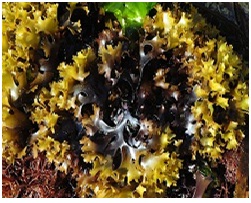 |
| Applications |
Marine (or blue) biotechnology encompasses the applications of biotechnology tools on marine resources. Marine biotechnology encompasses those efforts that involve the marine resources of the world, either as the source or target of biotechnology applications. Biotechnology is the application of science and technology to living organisms, as well as parts, products and models thereof, to alter living or non-living materials for the production of knowledge, goods and services'. In the case of marine biotechnology, the living organisms derive from marine sources. Biotechnology is defined as the industrial use of living organisms or biological techniques developed through basic research; marine biotechnology is an emerging discipline based on the use of marine natural resources. The oceans encompass about 71% of the surface of our planet, but over 99% of the biosphere (since organisms are found throughout the water column), and they represent the greatest extremes of temperature, light, and pressure encountered by life. Adaptation to these harsh environments has led to a rich marine bio- and genetic-diversity with potential biotechnological applications related to drug discovery, environmental remediation, increasing seafood supply and safety, and developing new resources and industrial processes.
Marine biotechnology may include techniques such as bioprocessing, bioharvesting, bioprospecting, bioremediation, using bioreactors etc (so called process biotechnology techniques); aquaculture/fisheries; gene, protein, or other molecule based techniques; while applications may include: health, food, cosmetics, aquaculture & agriculture, fisheries, manufacturing, environmental remediation, biofilms and corrosion, biomaterials, research tools etc. Therefore, marine biotechnology has a horizontal scope encompassing very different applications, for all of which the marine environment is providing the resources. This means everything from deriving a new cancer treatment from a deep-sea sponge to developing an innovative buoy system for monitoring ocean pollution. Like the broader field of biotechnology, marine biotechnology (marine biotech or MBT) can take very traditional forms, such as localized seaweed farming, and high-tech forms. The full range of genomic tools, for instance, is now being applied to such goals as determining precisely how a promising compound derived from a marine organism kills cancer cells. Commercial applications of marine biotechnology includes bio-prospecting, improving the production of marine organisms, production of novel products, particularly food and feed products and diagnostics and biosensors. Bioprospecting includes biotechnology use in whole drug/molecule development process, i.e. screening, identification, efficacy testing, safety testing, large scale commercial production. Bioactive natural products are secondary metabolites produced by organisms that live in the sea. These products have received increasing attention from chemists and pharmacologists during the last two decades. These products have been exploited for variety of purposes including use as food, fragrances, pigments, insecticides and medicines. Through improved biological screening method the role of these products in drug discovery has been greatly enhanced in the last few years. These products show an interesting array of diverse and novel chemical structures with potent biological activities.
Research into pharmacological properties of marine natural products has led to the discovery of many compounds considered worthy of clinical applications.There are great potential in bioprospecting from the sea and marine natural products research has just started to bloom.Today, marine sources have the highest probability of yielding natural products with unprecedented carbon skeletons and interesting biological activities.Many more prospects regarding new habitats for example deep ocean samplesand symbiotic systems are still wide open for research.
BIOPROSPECTING AND BIOTECHNOLOGY OF MARINE MICROORGANISMS
Following achievements have been recorded in the field of Bioprospecting and Biotechnology of marine microorganisms-
|
- Characterization of protease enzyme from a deep-sea fungus and increased production of the same using solif-substrate fermentation
- Decolorization of textile and paper mill effluents using laccase enzyme of a marine fungus NIOCC 2a, effect of different carbon and nitrogen sources in the culture medium for these processes
- Molecular sequencing of the ITS gene of rRNA of the marine fungus NIOCC 2a used for decolorization of colored effluents. The sequence has been deposited in the GenBank.
- Taxonomy of deep-sea yeasts using molecular sequencing of ITS region.
- Heavy metal tolerance and enzyme studies of thraustochytrids and bacteria isolated from hydrothermal vent
- Temporal changes in the diversity of fungi from Mandovi estuari in the oxic and anoxic zones.
- Aspecies of thraustochytrid, new to science, was described using sequences of 18S rRNAgene
- Deciphering the phylogenetic relationship of several fungi and yeasts from deep-sea sediments, water column, anoxic sediments and mangroves.
|
|
- Physiological studies on fungi from coastal anoxic, and deep-sea sediment
- Application of lignin-degrading fungal enzymes for reducing color, phenolics and COD from factory effluents.
- Demonstration of mercury resistant bacterial potential in breaking down TBT
- Elucidation of physiological pathways of a bacterium of high de-inking ability
- Recognition of spatial difference in heterotrophic bacterial abundance and production in the Bay of Bengal.
- Isolation of marine derived, endophytic and wood litter fungal strains for harnessing their enzymes and pigments.
|
Important bioactive compounds and their applications:
Molluscan Derived Compounds |
Dolastatins
Dolastatin 10 and dolastatin 15 were isolated from the Indian Ocean sea hare Dollabella auricularia. These small linear peptide molecules are promising anti-cancer drugs showing potency against breast and liver cancers, solid tumors and some leukemias. Preclinical research indicated potency in experimental antineoplastic and tubulin assembly systems. The dolastatins are mitotic inhibitors. They interfere with tubulin formation and thereby disrupt cell division by mitosis.
|
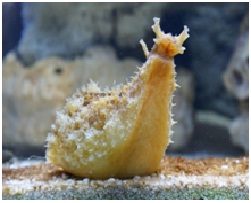 |
Kahalaide F
Kahalalide F was isolated from a sacoglossan (sea slug) mollusc, Elysia rufescens, collected from Hawaii. Kahalalide F appears capable of disrupting lysosome membranes within certain target cells, thereby initiating apoptosis (programmed cell death). The drug also appears to inhibit the expression of certain specific genes that are involved in DNA replication and cell proliferation, thereby inhibiting tumor spreading and growth.
|
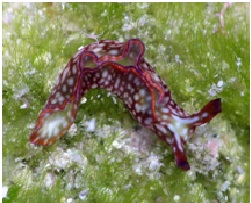 |
Spisulosine
Isolation of this natural product from the commercially harvested Arctic surf clam Spisula (=Mactromeris) polynyma by researchers from the Spanish PharmaMar group was first reported in 1999. The molecule shows promise as an antiproliferative (anti-tumor) agent, and has intriguing mechanism of action.
|
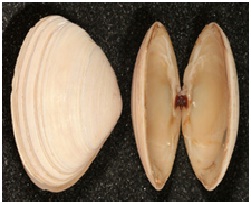 |
Ziconotide (Prialt¨)
Ziconotide is a synthetic derivative of short (25 amino acid) peptide extracted from the venom of predatory cone snails (Conus geographicus, Conus magus). This drug, a member of a newly described chemical family called the conopeptides, is a generating a lot of interest as a potential pain management drug. Results from clinical trials to date have suggested ziconotide's effectiveness in treating pain may be from fifty to several thousand times better than that of morphine. The fact that ziconotide and other conotoxins are short (usually 20-30 amino acids) means that synthetic derivatives are typically easy to produce. A synthetic version of the drug, SNX-111, is manufactured by licensee Elan Corporation under the trade name Prialt¨.
|
 |
Cadalmin TM Green Mussel Extract (GMe)
CMFRI was developed new product CadalminTM Green Mussel Extract (GMe) to combat arthritis. CadalminTM. GMe contains 100% natural marine bioactive anti-inflammatory ingredients extracted from green mussel Perna viridis. The product is effective to combat chronic joint pain, arthritis/ inflammatory diseases,and improves cardiovascular functioning. It is an effective green alternative to synthetic non steroidal anti-inflammatory drugs (viz., aspirin containing drugs having undesirable side effects). The active principle in CadalminTM GMe effectively inhibits inflammatory cyclooxygenase-II and lipoxygenase-V, and its activity was found to be comparable to the drugs available in the market. Consuming CadalminTM GMe will avoid unfortunate side effect of these synthetic non steroidal anti-inflammatory drugs. This product is a blend of nutraceutical and nutritional elements. CadalminTM GMe is designed to find a unique way to prevent the degradation by air, moisture, heat and light and to maximize the activity. The product is free from deleterious trans fatty acids, free radicals/free radical adducts, and low molecular weight carbonyl compounds.
|
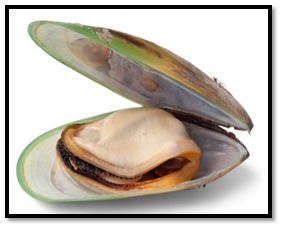 |
Vertebrate-Derived Compounds |
Squalamine
Squalamine is an aminosterol isolated from the stomach and liver of the spiny dogfish, Squalus acanthus, a common New England coastal shark species. When it was discovered in 1993, the compound was reported to exhibit broad-spectrum antibiotic activity. Squalamine was licensed to Magainin Pharmaceuticals (now Genaera Corporation) for development. Of considerable interest is published evidence suggesting that squalamine exhibits anti-angiogenic activity under certain conditions (angiogenesis is the formation and differentiation of blood vessels).
|
 |
Neovastat" (AE-941)
Neovastat (AE-941) is a derivative of shark cartilage extract. Rather than being a specific monomolecular compound, AE-941 is a defined standardized liquid extract comprising the < 500 kDa (kilodaltons, a unit of mass) fraction from shark cartilage. It has the anti-angiogenic and antitumor activity. The drug's anti-angiogenic bioactivity suggests it could be a valuable agent for use in patients suffering from multiple myeloma and other hematologic (blood) diseases.
|
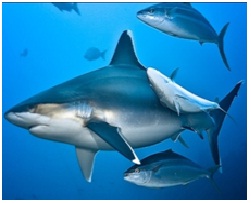 |
Sponge-Derived Compounds |
Bengamides and Derivatives
Two novel seven-membered ring heterocycles, bengamide A and bengamide B, were reported in 1986 isolated from an as yet undescribed Fijian sponge belonging to family Jaspidae. Since this time, a number of additional compounds from the bengamide class have been isolated, most notably from the Fijian sponge Jaspiscf. coriacea. Bengamides A and B were initially reported to exhibit in vitro toxicity to larynx epithelial carcinoma cells, and to have antibiotic and anti-helminthic activity (against the nematode Nippostrongulus braziliensis).
|
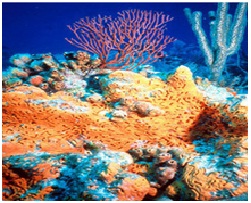 |
Contignasterol (IZP-94005, IPL576,092)
Contignasterol (IZP-94005) from the sponge Petrosia contignata was first reported in the early 1990s. The natural compound itself was deemed a good anti-asthma drug candidate based on performance in in vivo animal models. One contignasterol derivative, named IPL576,092, shows promise as an oral asthma medication. More recently, IPL576,092 has entered clinical trials as a treatment for diseases causing inflammation of the eyes and skin.
|
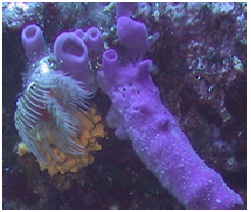 |
Debromohymenialdisine (DBH)
Debromohymenialdisine (DBH) is an alkaloid originally isolated from the shallow-water Palauan marine sponge Stylotella aurantium. The molecule is intriguing not just for its drug-like properties, but also because it's simple molecular structure has yielded to easy total synthesis in the laboratory. Research suggest the compound acts as a highly selective inhibitor of a specific target cell DNA damage checkpoint enzyme during the G2 phase of the cell cycle. The compound is a promising potential Anti-Alzheimer agent.
|
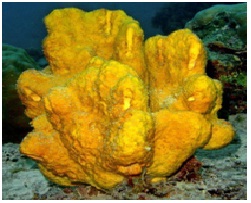 |
Discodermolide
Discodermolide, isolated from the Bahamian deep-sea sponge Discodermia dissoluta, is a promising marine-derived candidate for treating certain cancers. It was discovered in 1987. The drug, a macrolide (polyhydroxylated lactone), is a member of a structurally diverse class of compounds called polyketides. It has a noteworthy chemical mechanism of action. It stabilizes the microtubules of target cells, essentially arresting them at a specific stage in the cell cycle and halting cell division. In addition to anticancer properties, discodermolide possesses immunosuppresive and cytotoxic activity. The pharmaceutical company Novartis Pharma AG licensed discodermolide for commercial development in 1998. The drug is currently in Phase I human clinical trials and continues to show promise in combating pancreatic cancer and many other drug-resistant cancers. Recently published reports offer up the exciting finding that combination drug treatment using discodermolide and Taxolå in lung cancer patients exhibits several times the tumor fighting efficacy of either drug administered on its own.
|
 |
Girolline (Girodazole)
Girolline was reported to inhibit protein synthesis in eukaryotic target cells. The compound was of interest because it inhibited protein synthesis at the termination steps of the process rather than at the initiation or chain elongation steps. The simple structure of the compound facilitated the production of a modified synthetic analog.
|
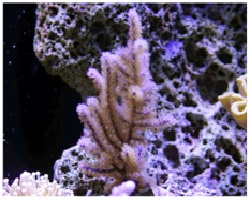 |
Halichondrins
A compound given the name halichondrin B, belonging to a chemical family known as the macrolides, was isolated by Uemura et al. (1985) from the Japanese sponge Halichondria okadai. Initial investigations into the bioactivity of the compound revealed that halichondrin B apparently bound tubilin at a site close to the so-called vinca site and altered tubulin depolymerization.
|
|
Hemiasterlins (H-286)
This class of novel marine oligopeptides have been shown to be potent antitumor agents. Representatives of this class of natural products have been isolated from extracts prepared from sponges residing in two distinct genera (Auletta; Siphonochalina). Three different hemiasterlins with drug development potential (hemiasterlin, hemiasterlin A, hemiasterlin C) have been the subject of chemical and biological investigations. These molecules exhibit cytotoxic and antitubulin activity similar to that seen in the dolastatins. Mitotic inhibition occurs through binding to tubulin at the vinca/peptide region in a manner similar to dolastatin.
|
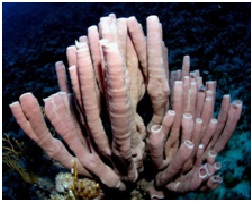 |
KRN7000
It was first isolated from the sponge Agelas mauritianus. These compounds, dubbed the agelasphins, were shown to exhibit antitumor and possible immunostimulatory activity.
|
 |
Lasonolides
The lasonolides are a series of marine natural products under investigation for the treatment of cancer. The compounds were isolated in 1994 by scientists from the Harbor Branch Division of Biomedical Marine Research from the sponge Forcepia sp. found in Gulf of Mexico deep-sea habitats. These compounds are very potent and show especially promising properties for the treatment of pancreatic cancer. They kill cancer cells in a different way than most other cancer drugs. The exact mode of action is not yet fully understood, and is an area of active research. In addition to anti-proliferative and antitumor properties, these novel macrolide compounds display antifungal activity as well.
|
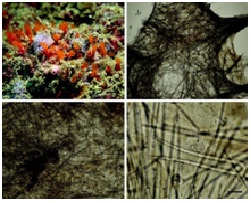 |
Manoalide
Manoalide was isolated from the sponge Luffariella variabilis collected in the Indo-Pacific. It is a member of a chemical family known as the sesquiterpenes.
Although this natural product was originally reported as an antibiotic, follow-up work revealed manoalide possesses promising analgesic and anti-inflammatory properties. The compound works by inhibiting Phospholipase A2 (PLA2), which plays an important role in the inflammation process.
|
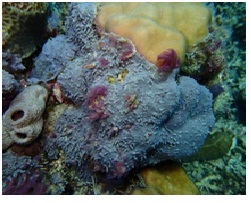 |
Topsentins
The Topsentins are a class of natural products that have been extracted from several sponge species subsequent to their initial isolation from the sponge Spongosorites ruetzleri. These compounds have been shown to have significant anti-inflammatory properties. Although the precise mode of action is not known, the compound has been reported capable of suppressing immunogenic as well as neurogenic (originating in nerve tissue) inflammation. The topsentins may hold promise as an arthritis medication or as additives in anti-inflammatory creams for the treatment of skin irritations.
|
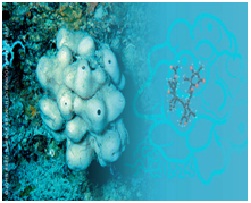 |
Dictyostatin
Dictyostatin was first isolated in 1994 by Bob Pettit and his colleagues at Arizona State University from a sample of an unidntified dictyoceratid sponge of genus Spongia collected in Jamaica. The compound was later isolated from from a lithistid sponge of the family Corallistidae and has been more fully repurified and characterized by researchers at Harbor Branch Oceanographic Institution and elsewhere. Dictyostatin inhibits the growth of human cancer cells and has been shown active against certain Taxol-resistant tumors. Its mechanism of action appears to be prevention of the breakdown of tubulin during mitosis in a fashion similar to the successful cancer drug Taxol.
|
 |
Laulimalide
Sometimes referred to as the fijianolides, the natural products laulimide and (the significantly less bioactive) isolaulimide were first extracted from the Pacific sponge Cacospongia mycofijiensis. The bioactivity displayed by these compounds is as microtubule stabilizing agents potentially arresting the development of target cells.
|
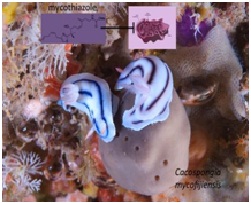 |
Peloruside A
University of Victoria scientist Peter Northcote and colleagues recovered the compound Peloruside A from the sponge Mycale hentscheli collected from Pelorus Sound, New Zealand. Peloruside A appears to bind tubulin and arrests target cell development at the G2-M transition stage of the cell cycle, triggering apoptosis ('cell suicide') before mitosis (M Phase) can begin.
|
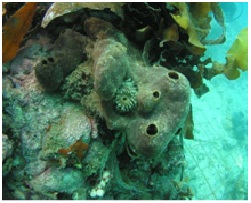 |
Salicylihalamides
The Vo-ATPases are a group of eukaryotic enzymes whose principal role is to pump hydrogen ions across cell vacuolar membranes. Salicylihalamides A and B, isolated from the sponge Haliclona sp. collected off of Westaen Australia, displays Vo-ATPase inhibitory activity that may eventually be incorporated into a drug designed to target these cell components. In addition to having potential as anti-tumor compounds, Vo-ATPases like the salicylihalamides may be capable of mediating the process of bone resorption. In this capacity, the compounds might form the basis for treatment of osteoporosis and similar diseases.
|
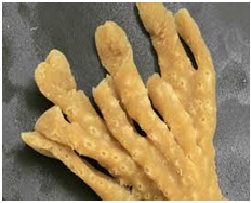 |
Cnidarian Derived Compounds |
Pseudopterosins
The pseudopterosins were isolated from a Caribbean soft coral species called a sea whip (Pseudopterogorgia elisabethae). They belong to a class of compounds known as tricyclic diterpene glycosides. Pseudopterosins have been shown to possess potent anti-inflammatory and analgesic (pain relief) properties. They appear to work by inhibiting the synthesis of eicosanoids, (locally functioning hormone-like substances) in specific white blood cells called polymorphonuclear leukocytes.
|
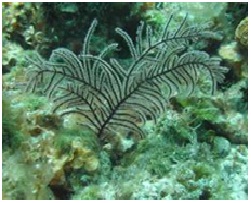 |
Eleutherobin
Eleutherobin was first found in extracts made from the octocoral Eleutherobia sp. collected in Australia. The reported bioactivity of this natural product, currently under preclinical investigation, is as a microtubule binding agent similar to the anti-cancer drug taxol.
|
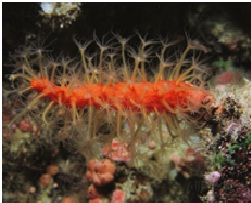 |
Sarcodictyins
Sarcodictyins were isolated from two Mediterranean coral species, Sarcodictyon roseum and Eleutherobia aurea. It acts as tubulin interactive agents.
|
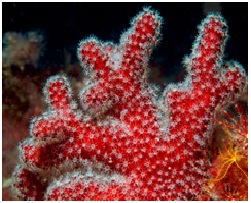 |
Ascidian Derived Compounds |
Aplidine (Aplidin¨)
Aplidine (Dehydrodidemnin B), has was isolated from the Mediterranean tunicate Aplidium albicans. It was first reported in a 1991 patent application. In preclinical animal tests, Aplidine exhibited anticancer properties. Aplidine differs chemically from didemnin B and the other didemnins only in the structure of its side chain. This fact, along with the small size and relatively simple structure, has allowed research to achieve total synthesis of didemnin analogs. The molecule has been described as a multifactorial apoptosis inducer, and it has other beneficial attributes such as low toxicity and a high specificity for tumor cells. The compound also inhibits the expression of receptor proteins (ornithine descarboxylase) and the secretion of proteins (vascular endothelial growth factor) involved in growth and vascularization of certain tumor types.
|
 |
Didemnin B
Didemnin B was originally isolated from the Caribbean tunicate Trididemnum solidum and first reported in the literature in 1981. Early investigation into the bioactivity of this compound revealed marked antiviral and cytotoxic activity in in vitro tests using standard mouse leukemia cell lines. Mechanistically, Didemnin B interrupts protein synthesis in target cells by binding non-competitively to palmitoyl protein thioesterase. Didemnin B was the first defined marine natural product to enter clinical trials as a potential anti-cancer drug.
|
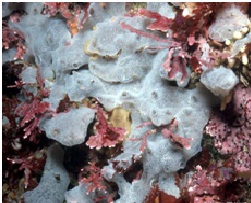 |
Ecteinascidin 743 (Yondelis¨)
Ecteinascidin 743 was isolated from the Caribbean sea squirt (Ascidia) Ecteinascidia turbinate. It is classified as a tetrahydroisoquinoline alkaloid. Preclinical trials showed ET-743 was active against a range of tumor types in standard animal models. Subsequent human trials showed efficacy against advanced soft tissue sarcoma, osteosarcoma and metastatic breast cancers. Research into the mode of action of ET-743 has revealed that binding of the drug to target cell DNA inhibits cell division and leads to apoptosis of cancer cells. ET-743 has been co-developed under the trade name Yondelis¨ by the Spanish marine pharmaceutical company PharmaMar and Johnson & Johnson subsidiary Ortho Biotech.
|
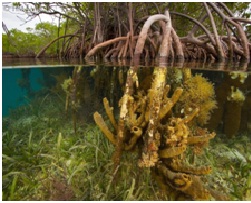 |
Diazonamide A
The marine natural product Diazonamide A was first reported in 1991. It was extracted from the Philippine ascidian Diazona angulata by the William Fenical Chemistry Lab at the Scripp's Institution of Oceanography. Both analogs possess potent microtubulin interactive activity. Diazonamide A is an inhibitor of microtubule assembly, arresting the process of cell division in cultures exposed to treatment. Examination of treated cells reveals a loss of spindle microtubule assemblies and also microtubules associated with the interphase stage of the cell cycle.
|
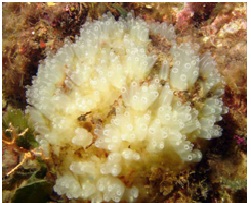 |
Vitilevuamide
Vitilevuamide is a bioactive cyclic peptide has been isolated from the ascidians Didemnum cuculiferum and Polysyncraton lithostrotum (the same animal is the source of the antimicrobial/antitumor compound namenamicin). Vitilevuamide is one of several novel tubulin interactive agents recently discovered from marine invertebrate sources. Research on the mechanism of action of this two-ringed marine peptide reveal that vitilevuamide inhibit tubulin polymerization and can arrest the cell cycle of target cells in the G2/M phase.
|
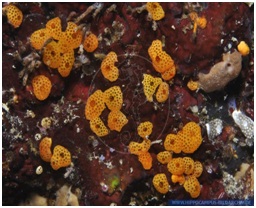 |
Bryozoans Derived Compounds |
Bryostatin 1
This natural product was originally extracted from the bryozoan (a sessile, moss-like marine animal) Bugula neritina collected in the Gulf of California and Gulf of Mexico. More recent work has demonstrated that the compound is most likely produced by the microbial symbiont Endobugula sertula. This compound and other bryostatins produced by the microbial associate are exploited by the host as a chemical means of defense, particularly in the larval stage. Bryostatin 1 is a macrocyclic lactone that belongs to a diverse class of complex products called polyketides. The compound has demonstrated promising anti-cancer, anti-tumor, and immunostimulant activities that are apparently related to its ability to bind to protein kinase C, and enzyme involved in the up-regulating (switching on) and down-regulating (switching off) of certain proteins.
|
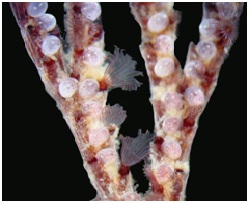 |
Helminth Derived Compounds |
Anabaseine (Hoplonemertine toxin)
Anabaseine is a nicotinoid alkaloid. It is capable of stimulating vertebrate neuromuscular nicotinic receptors and increasing cholinergenic transmission. As such it has potential as a treatment of cognitive function loss. A synthetic analog, DMXBA (GTS-21) has exhibited memory enhancing effects in recipients. The compound is currently under license by the Japanese pharmaceutical company Taiho and is in Phase I trials for treating Alzheimer's disease.
|
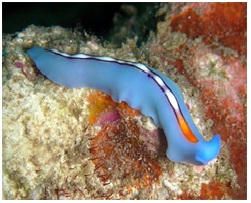 |
Microbe Derived Compounds |
Cryptophycins
This family of compounds was initially reported from a terrestrial source (the Nostoc sp. cyanophyte component of a Scottish lichen). Representative compounds have also been found in species of free-living marine and non-marine cyanophytes and, more recently, from the Japanese sponge Dysidea arenaria. The expressed bioactivity that was originally pursued was activity as an antifungal agent. Development of the compound for this purpose was not pursued beyond preliminary investigations when it was deemed too toxic for human use. More recently it has been reported that cryptophycin 1 is an inhibitor of tubulin assembly in cells. |
 |
Curacin A
First isolated from Lyngbya majuscula by Gerwick et al. and reported in 1994, this natural product appeared to be a very potent tubulin interactive compound. It proved to be highly insoluble, however, so much so that bioactivity could not be demonstrated with in vivo animal models.These compounds are currently undergoing preclinical evaluation as potential future drugs. |
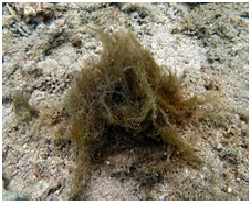 |
Thiocoraline
Belonging to the chemical family known as the thiodepsipeptides, thiocoraline was first isolated from Micromonospora marina, an actinomycete bacterium collected from coastal Mozambique, southeast Africa. The Spanish marine drug company PharmaMar has reported that the compound shows activity against several standard drug screens, including breast cancer, colon cancer, renal cancer, and melanoma. Target cells appear to be inhibited through inhibition of DNA polymerase ± enzyme.The most recent published literature suggests thiocoraline is still undergoing advanced preclinical evaluation.
|
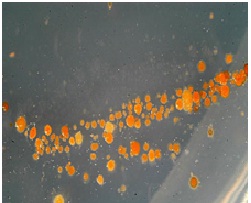 |
The Future Of Marine Bioprospecting |
the near future, marine bioprospecting efforts will likely focus not only on natural products from ocean plants, animals, and microbes, but also on the potential for biotech to exploit the information stored in the genomes of these organisms. In the wake of the Human Genome Project and with the expertise and technology that emerged from it, scientists are sequencing increasing numbers non-human genomes. Total genome sequencing of a handful of marine microbes has been completed, and the first sequencing of marine vertebrate (e.g., fish) genomes has commenced as well. This and similar research will likely lead to the development of gene probes that can identify the genes in target organisms that code for the elaboration of novel natural products of potential value to humans. Increasingly, new projects are expected to target the as yet unrealized biomolecular potential of the vast and almost entirely unknown marine microbial community. These research efforts could be instrumental in developing the next generation of pharmaceuticals for improving human health, as well as contributing to improved animal and agricultural crop health.
In summary, the marine world has become an important source of therapeutic agents with novel mechanisms of action. Even though thousands of new molecules are discovered every year only small number of candidates is incorporated in clinical trials. The main problem underlying this is sustainable supply of these compounds from natural sources. To battle this problem various strategies are developed, such as mariculture or aquaculture of source organisms, development of synthetic analogues of active compounds, fermentation of microorganisms producing the compound, etc. Another possible solution is the use of genetic engineering to transfer the genes encoding the synthetic enzymes that produce the desired compound to microorganisms that can be grown in huge quantities. Development of these products and services, as well as the fundamental research from which they must be derived will be enhanced by greater dependence on interdisciplinary sciences such as pharmacology, chemical ecology, molecular biology, genomics, metagenomics, computational and combinatorial chemistry and biology.
The field of marine natural products is passing its discovery phase and moving to the second phase where understanding relationships and processes is driving the research towards novel drugs from the sea. Marine plants, animals and microorganisms will be the basis of new products and services important to technology in the future. With rich biodiversity and vast marine resources along the Indian coast, in the form of estuaries, creeks, deep seas and continental shelf, the opportunities for research in the area of marine drug development are endless
|
Environmental Applications of Marine Biotechnology. |
Marine biotechnology is now poised to enter a phase of rapid growth in commercial and environmental applications. In the environmental arena, appropriate applications of marine biotechnology will help retain environmental productivity and restore environmental quality. Most marine pollution problems occur in coastal areas, but originate in terrestrial inputs. Rivers carry pollutants to the sea from various inland sources. Agricultural practices including the widespread use of fertilizers, pesticides, and herbicides lead to nonpoint-source leaching of contaminants directly into the oceans from coastal regions and indirectly by rivers. Many shore-based operations, such as ship loading, result in point discharges of a variety of pollutants. In contrast, only a few problems arise offshore, such as those related to oil well blowouts and wrecks of oil tankers, and these problems have few measurable effects unless shorelines become contaminated. The vast dilution capacity of the sea and the degradative capacities of diverse marine microorganisms minimize the effect of contaminants. Protecting and restoring the marine environment has become an increasingly high international priority, and marine biotechnology can play many roles. We have chosen to discuss six environmental application areas of marine biotechnology.
1. Waste processing and treatment
2. Monitoring of general ocean pollution
3. Bioremediation of spilled oil
5. Bioremediation of dredged sediments
6. Environmental restoration and preservation
7. Marine biotechnology and global
|
Waste Processing and Treatment. |
Although advanced waste-treatment facilities are now a standard feature of many cities and the technology is mature, many coastal communities either do not treat their sewage or use only primary screening to remove solids before discharging it into the sea. Only some 10% of the total global production of waste is treated, and the remainder can place a severe burden on natural self-purification processes, particularly in the marine environment.
The sediments that receive such sewage often become anoxic, so there is little marine life, and biodegradation, which is often most rapid under aerobic conditions, is slowed. Natural-cleansing processes are thus inhibited and, once problems occur, they tend to be self-amplifying so that the problem impinges on an ever greater area. Polychlorobiphenyls (PCBs) and other xenobiotic pollutants and heavy metals in sewage also contaminate sediments.
Modern biotechnology has much to offer the waste-treatment industry that produces effluents that enter marine ecosystems.
Recent work has focused on better removal of nitrogenous and phosphorus nutrients, which stimulate algal growth in outfall areas. Removing nitrates and phosphates prevents eutrophication in coastal waters that receive sewage effluent.
|
Monitoring of General Ocean Pollution |
Modern biotechnology is providing numerous and powerful new ways to define the extent of marine pollution caused by coastal runoff and deliberate inputs. Understanding the extent of the effect of ocean pollution is clearly an important determinant of whether remediation is needed, or will be needed in the future.
Examples include:
• Using common bivalves, such as blue mussels and oysters, to monitor chemical contaminants in coastal waters.
• Enzymatic techniques are widely used to monitor the exposure of marine species to pollutants. e.g., the cytochrome P450- dependent monooxygenases is widely used as a biomarker of exposure to halogenated aromatic hydrocarbons (HAHs) and polynuclear aromatic hydrocarbons (PAHs).
|
Bioremediation of Spilled Oil |
Crude oil has been a part of the natural marine environment for millennia; oil seeps add an estimated 90 × 106 gal/year. It is not surprising that hydrocarbon-degrading bacteria are found in all environments where they have been looked for. Today, total input of oil into the sea is perhaps ten times greater, with most of the additional oil coming from municipal runoff and shipping. Additional sources of oil pollution (Fig.)
Most oil enters the marine environment released by human’s activities. These include:
• The extraction operation from the seabed,
• The transportation across the oceans,
• The refining in plants along the coast.
• discharging oil by oil tankers while unloading,
• The illegally cleaning the tankers tanks at sea and emptying the water they use as ballast on their return trips to load oil.
• The blowouts of offshore rigs used in the extraction of oil.
• The sinking or collision of supertankers.
source: http://site.iugaza.edu.ps/elnabris/files/2010/02/4-Environmental-Applications-of-Marine-Biotechnology.pdf
|
Marine biotechnology advances towards applications in new functional foods. |
Marine resources are a source of high value-added compounds with nutraceutical value to be used as functional ingredients: omega-3 oils, chitin, chitosan, fish protein hydrolysates, algal constituents, carotenoids, collagen, taurine and other bioactive compounds(Kadam and Prabhasankar, 2010), are examples of such compounds
that can be added at different stages, from processing to storage, of
the food production process. Supplementation of foods with functional or bioactive ingredients has become an increasingly interesting way to develop new functional foods for the so called healthconscious consumers. In Fig. 1 the main marine functional ingredients, their inherent functionality and potential food applications are displayed
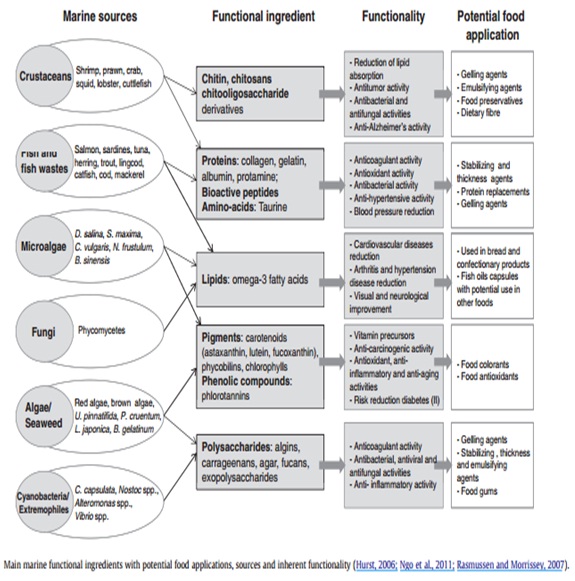
|
Policy to support marine biotechnology-based solutions to global challenges |
advances in science and technology are igniting new interest in marine biotechnology. Governments are recognizing the potential of marine biotechnology to provide solutions to grand global challenges of population health, food, and energy security and sustainable industry. This paper examines some of the challenges to and policy options for the development of marine biotechnology.
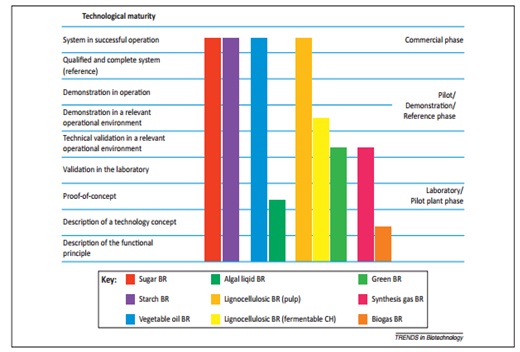
|
Fig. The technological maturity of various biorefinery concepts, demonstrating that algal lipid biorefineries are among the least advanced and furthest from market. Redrawn from Abbreviations: BR, biorefinery; CH, carbohydrate
|
Reference: |
Anil Kumar. 2010. Marine Biotechnology in India. Advances In Bioresearch, Vol 1 [1] :1 – 9
Saradavey Vinothkumar and.Parameswaran. P.S. 2013. Recent advances in marine drug research. Author version: Biotechnol. Adv., vol.31(8); 1826-1845
Khandeparker, L., Anil, A.C. and Raghukumar, S. (2006).Relevance of biofilm bacteria in modulating the larval metamorphosis of Balanus amphitrite. FEMSMicrobiol. Ecol., 58(3),:425-438.
De, J., Ramaiah, N. and Sarkar, A. (2006).Aerobic degradation of highly chlorinated polychlorobiphenyls by a marine bacterium, Pseudomonas CH07. World J. Microbiol.Biotechnol., 22(12),:1321-1327.
Sumathi, J.C., Raghukumar, S., Kasbekar, D.P. and Raghukumar, C. (2006).Molecular evidence of fungal signatures in the marine protist Corallochytrium limacisporum and its implications in the evolution ofanimals and fungi. Protist., 157(4), :363-376.
Bioprospecting of Marine Bioresources in India |
Some leading universities offering the marine biotechnology courses in India |
| 1. Andhra University
Visakhapatnam - 530 003
Andhra Pradesh, India
Andhra University is not just one of the oldest educational institutions in the country, but is also the first to be conceived as a residential and teaching-cum-affiliating University, mainly devoted to post-graduate teaching and research.
Andhra University was constituted in the year 1926 by the Madras Act of 1926. The 86-year-old institution is fortunate to have Sir C.R. Reddy as its founder Vice-Chancellor, as the steps taken by this visionary proved to be fruitful in the long run.
Former President of India Dr. Sarvepalli Radhakrishnan was one of its Vice-Chancellors who succeed Dr. C. R. Reddy in 1931. The University College of Arts was inaugurated on 1 st July, 1931. The inaugural courses were Telugu language and literature, History, Economics and Politics. A year later, the College of Science and Technology came into being with Honours courses in Physics and Chemistry. The University pioneered in introducing many new courses in Science, Arts, Management and Engineering in the country.
|
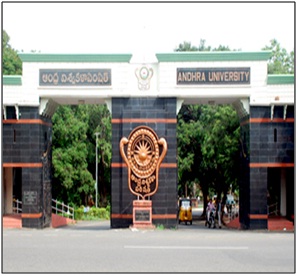 |
Objectives:
- Creating awareness and keep the University academic Community up to date on the on-going research in the University Campus.
- Coordinating research activities and providing a forum for exchange of views.
- To explore the possibility of inter-disciplinary research and encourage the young researchers in this direction.
- Bringing out a bulletin for dissemination of useful information to researchers in various fields.
- Discuss the methodological issues, interpretation of conceptual and analytical framework, findings of empirical studies, policy implications, etc. of the on-going and completed research programmes through regular meetings of faculty and research scholars.
- Encouraging young scholars to gain knowledge of the perspectives and methodologies of their own and related disciplines through active participation.
More: http://www.andhrauniversity.edu.in/# |
2. Academy of Maritime Education and Training (AMET) University
East Coast Road
Kanathur, Chennai
Tamil Nadu 603112
Academy of Maritime Education and Training (AMET) University which is India’s first maritime University, the one and only university from India to be a member of the International Association of Maritime Universities. With quality, commitment, knowledge and excellence as its corner stones, AMET had a humble beginning in the year 1993 with just 14 cadets molded for a career in merchant navy through a higher national diploma programme in marine engineering.
AMET’s uncompromising strides of excellence in the field of maritime education and training laced with its capacity to feed the global shipping industry with an unrivalled maritime human resource secured it the status of becoming the first university in India for maritime education, training, research and development activities on the 21st August 2007. AMET had the privilege and unprecedented status of getting unveiled as a Maritime University from the hands of the secretary general of the International Maritime Organization, Mr.Efithimios E Mitrapoulos.
|
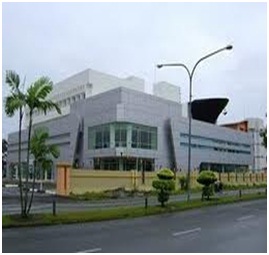 |
VISION: To place Academy of Maritime Education and Training (AMET) to a position of prominence among the world's Maritime Universities.
MISSION: To be the fountainhead for nurturing finest intellectual capital base for the maritime sector - worldwide.
The thrust areas of the Centre are:
- Maritime Education
- Marine Engineering
- Nautical Science
- Naval Architecture & Offshore Engineering
- Harbour and Ocean Engineering, Coastal Engineering
- Coastal / Marine Management
- Inland Water Studies
- Estuarine Studies
- Petroleum Engineering
- Maine Electrical and Electronics Engineering
- Maritime Policies
- Shipping and Logistics Management
- Maritime Law & Marine Insurance
- Maritime Fleet Operations Management
- Port Management, Marine Biotechnology
- Allied Sciences (Physics, Chemistry, Maths, English, Life Sciences) and Marine Information Technology
- Interdisciplinary
This centre functions with full commitment towards Research and Development of societal importance with the enthusiasm to serve the community at large.
More: http://www.ametuniv.ac.in |
| 3. Goa University
Taleigao Plateau, Goa
Goa University, established in June 1985 by an Act of Goa Government, is located on a picturesque campus spread over 427.49 acres area of Taleigao Plateau overlooking the Zuari Estuary, within close vicinity of the capital city of Panaji, in North Goa. Besides being the most important location for post-graduate studies, it also serves as the academic nerve-centre of the higher education system in Goa. Today Goa University, is a university of affiliated colleges, 55 of which are distributed across Goa, 30 in general education, 25 in professional education. Presently, Goa University has 12 faculties of which 6 faculties operate on the campus with 24 Departments and 3 Research Centers that offer post-graduate education in the State of Goa.(Ranked 14th among the Top Universities of India (India Today - AC Nielsen, 2014).
More: https://www.unigoa.ac.in/index.php
|
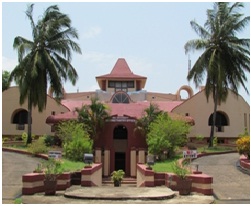 |
| 4. Annamalai University
Chidambaram
Tamil Nadu 608002
The Annamalai University is a unitary, teaching, and residential university. It was founded by the munificence of the farsighted and noble hearted philanthropist and patron of letters the late Hon’ble Dr. Rajah Sir Annamalai Chettiar of Chettinad, Kt, LL.D., D.Litt. He started several colleges, and ultimately, the University in 1929. Since its inception, it has progressively tried to realize the aims of the noble Founder Pro-Chancellor. After him, his illustrious son, Padma Bhushan Dr. Rajah Sir Muthiah Chettiar of Chettinad, was the Pro-Chancellor from 1948 to 1984, and he sedulously nurtured the growth and development of the University. The University has had the unique good fortune of having a succession of eminent Vice-Chancellors to guide its destinies. During the last eighty two years the University has grown rapidly and has consolidated its position as a unitary and residential University with forty-nine Departments of Study and over 3240 members on its teaching staff. Annamalainagar is already a busy and full-fledged University town, east of Chidambaram, the abode of Lord Nataraja. The University campus, including the colleges, hostels, and playgrounds, occupies an area of about thousand acres.
More: https://www.annamalaiuniversity.ac.in/
|
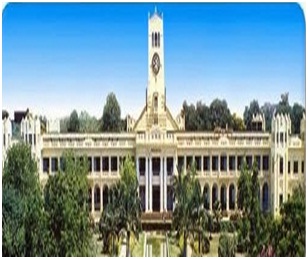 |
| 5. Cochin University of Science and Technology
Cochin, Kerala
The University’s basic philosophy and goals find eloquent expression in its Coat of Arms emblazoning the motto “Tejaswinavadhitamastu” which in essence means “may the wisdom accrued defy us both the teacher and the taught and percolate to the Universe in its totality”, which in essence means “may learning illumine us both” (the teacher and the taught).
|
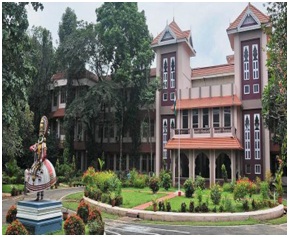 |
The University shall have the following objectives as its mission:
(i) to prosecute and promote research in applied science, technology, industry, commerce, management and social science for the advancement of knowledge and for the betterment of society;
(ii) to provide facilities and offer opportunities for graduate and post-graduate education in applied science, technology, industry, commerce, management and social science by instruction, training, research, development and extension and by such other means as the University may deem fit;
(iii) to devise and implement programmes of education in applied science, technology, industry, commerce, management and social science that are relevant to the changing needs of society, in terms of breadth of diversity and depth of specialization;
(iv) to serve as a centre for fostering co-operation and exchange of ideas between the academic and research community on the one hand and industry on the other;
(v) to organise exchange programmes with other institutions of repute in India and abroad with a view to keeping abreast of the latest developments in relevant areas of teaching and research.
More: http://www.cusat.ac.in/
|
| 6. Bharathidasan University
Palkalaiperur, Tiruchirappall
Tamil Nadu, India.
Bharathidasan University established in February 1982, and was named after the great revolutionary Tamil Poet, Bharathidasan (1891-1964). The University's main Campus was initially located in a sprawling area of over 1000 acres in Palkalaiperur. However, as years passed on, the South Campus at Palkalaiperur with the available infrastructure was donated to the newly started Anna University of Technology. Very recently, another portion of the land has been allotted to the Indian Institute of Management (IIM), Tiruchirappalli. Also, the University has a downtown campus at Khajamalai, which housed originally the Autonomous Post-Graduate Centre of the University of Madras at Tiruchirappalli. In addition to the regular teaching programmes in the Departments and Schools, the University under its Distance Education mode is conducting 15 UG and 26 PG programmes. All the UG and PG programmes are conducted under non-semester system and MCA and MBA programmes are conducted under semester system along with the regular programmes. The MCA and MBA programmes conducted under this mode are very popular.
|
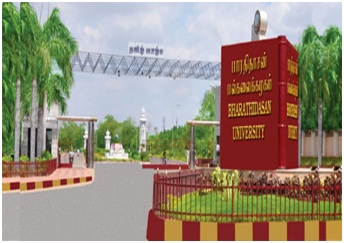 |
Department of Marine Biotechnology
India occupies a strategic position in the Indian Ocean, with a large Exclusive Economic Zone, EEZ of about 2.172 million square kilometers in the area along 7500 Km coastal line, shelf area of 1,641,514 KM2. A major challenge facing India in the 21st century is to continue to advance in science to provide for the sustainable development and management of this vast realm. There is a need for well trained marine scientists in a range of disciplines within India. As Marine Biotechnology is interdisciplinary and multidisciplinary subject, Department of Marine Biotechnology was newly created as per the syndicate resolution 2008.176. dt.18.9 2008. Department offers 2 year M.Sc. Programme on Marine Biotechnology, and M.Phil and Ph.D Programmes in Microbial Biotechnology.
Mission: Creating an arena for bioprospecting of marine organisms through innovative teaching and research.
Vision: Using the tools of Biotechnology, the vast and potential marine source to be explored for newfoods, -pharma,-netura, -cosmaceuticals and energy to meet out the needs.
More: http://www.bdu.ac.in/
|
| 7. Alagappa University
Karaikudi - 630 003
Tamilnadu
Alagappa University is located at Karaikudi in Tamil Nadu is accessible from Madurai and Tiruchirappalli Airports within two hours. The 440 acre green and lush campus houses all the academic activities. This University has emerged from the galaxy of institutions initially founded by the great philanthropist and educationist Dr. RM. Alagappa Chettiar.
Research is one of the strongest components of Alagappa University. All the faculty members of the University have been actively engaged in research. With financial support from national/international agencies like DST, DBT, UGC, CSIR, ICMR, DRDO, MHRD, UNESCO, etc., various research projects are being carried out. Currently 70 projects with external funding to the tune of Rs.1400 lakhs are on-going. The University Grants Commission has been supporting the Departments of Physics, Chemistry and Biotechnology and Physical Education under Special Assistance Programme (SAP). Similarly, the Department of Science and Technology (DST), Ministry of Science and Technology, Government of India has been supporting the Departments of Physics, Chemistry and Biotechnology under “Fund for Improvement of S&T Infrastructure in Universities and Higher Educational Institutions (FIST)" scheme. Alagappa University has got 27th rank at the national level. The University's motto is "Excellence in Action" and the University keeps before it the vision of excellence in all spheres of its action.
More: http://alagappauniversity.ac.in/
|
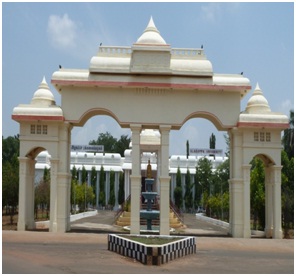 |
8. Pondicheery University
R.V. Nagar, Kalapet,
Puducherry - 605 014.
The Department of Ocean Studies and Marine Biology was established in the year 2000 as a Centre of Ocean and Island Studies and upgraded to the present Department in the year 2004. This Department is located in a sprawling campus of its own at Brookshabad (Port Blair), the picturesque capital city of the Andaman and Nicobar islands. The Department has well equipped infrastructural facilities with laboratories and instruments for both the academics and research activities with extramural funding from UGC, DST and MoES. The Department is well poised to train by imparting education and field based practical training to the students in the arena of Marine Biological Sciences.
|
 |
The program is primarily focused at building trained manpower with skills required to cater to the need in the field of Marine Biology. Department has the mandate for exploring the potential of marine living and nonliving resources and their application, developing sustainable management strategy for the resources, creating database on all the oceanographic components involving biological, chemical, physical and geological aspects of the Andaman Sea preferentially.
The Department conducts M. Sc. and Ph. D. Program in Marine Biology and it’s strategic location at Port Blair in close proximity with the Andaman Sea provides unique opportunity for the students and researchers to get extensive exposure to a vivid form of marine environmental conditions comprising estuarine, mangrove, Island and marine ecosystems. Students to the program are admitted on the basis of the rank obtained by all India entrance examination conducted by the Pondicherry University at different centers in the country. The students enrolled for the Master degree are offered a studentship of Rs. 1000 per month.
More: http://www.pondiuni.edu.in/ |
| 9. Berhampur University
Bhanja Bihar, Behrampur-760007
The Berhampur University came into existence on 2nd January 1967 being inaugurated by Dr. A.N. Khosla, the then Governor of Orissa and the first Chancellor of the University. The University was later shifted to the present site known as Bhanja Bihar, named after the celebrated poet of Orissa Kabisamrat Upendra Bhanja. Spreading over an area of about two hundred fifty acres the university is twelve kilometres and 5 kilometers away from the Berhampur City and Sea-beach of Gopalpur respectively.
There are twenty post-graduate departments in the university offering specialized subjects and M. Phil programmes. Some of the faculties like Mass Communication, Tourism and Indian Monuments, Electronic Science, Computer Science, Marine Science, Military Science make the University stand apart from some other universities of the country.
More: http://www.buodisha.edu.in/
|
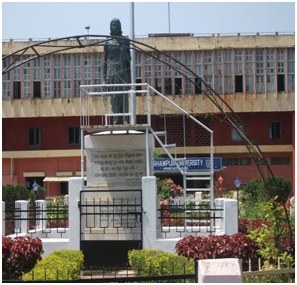 |



